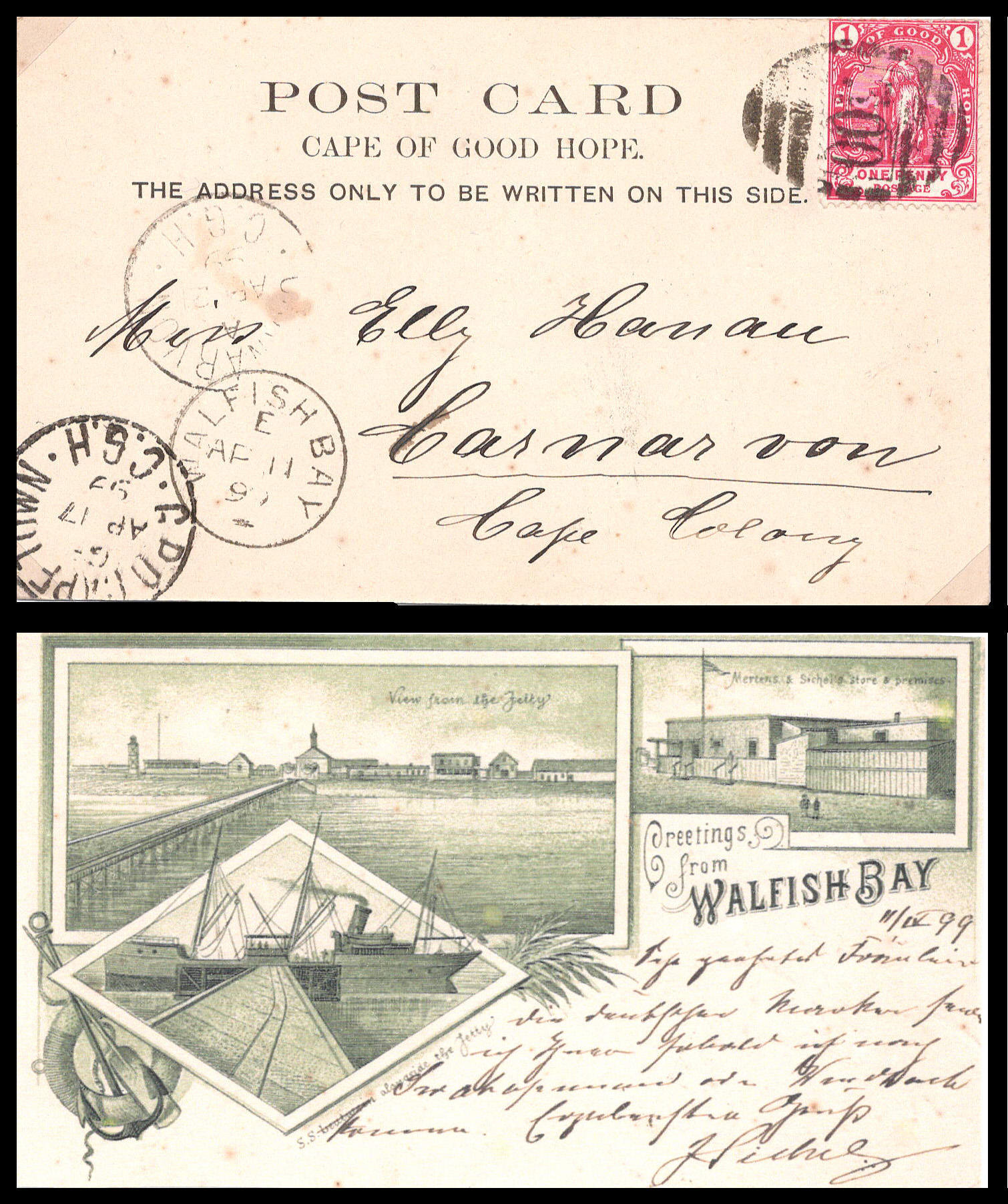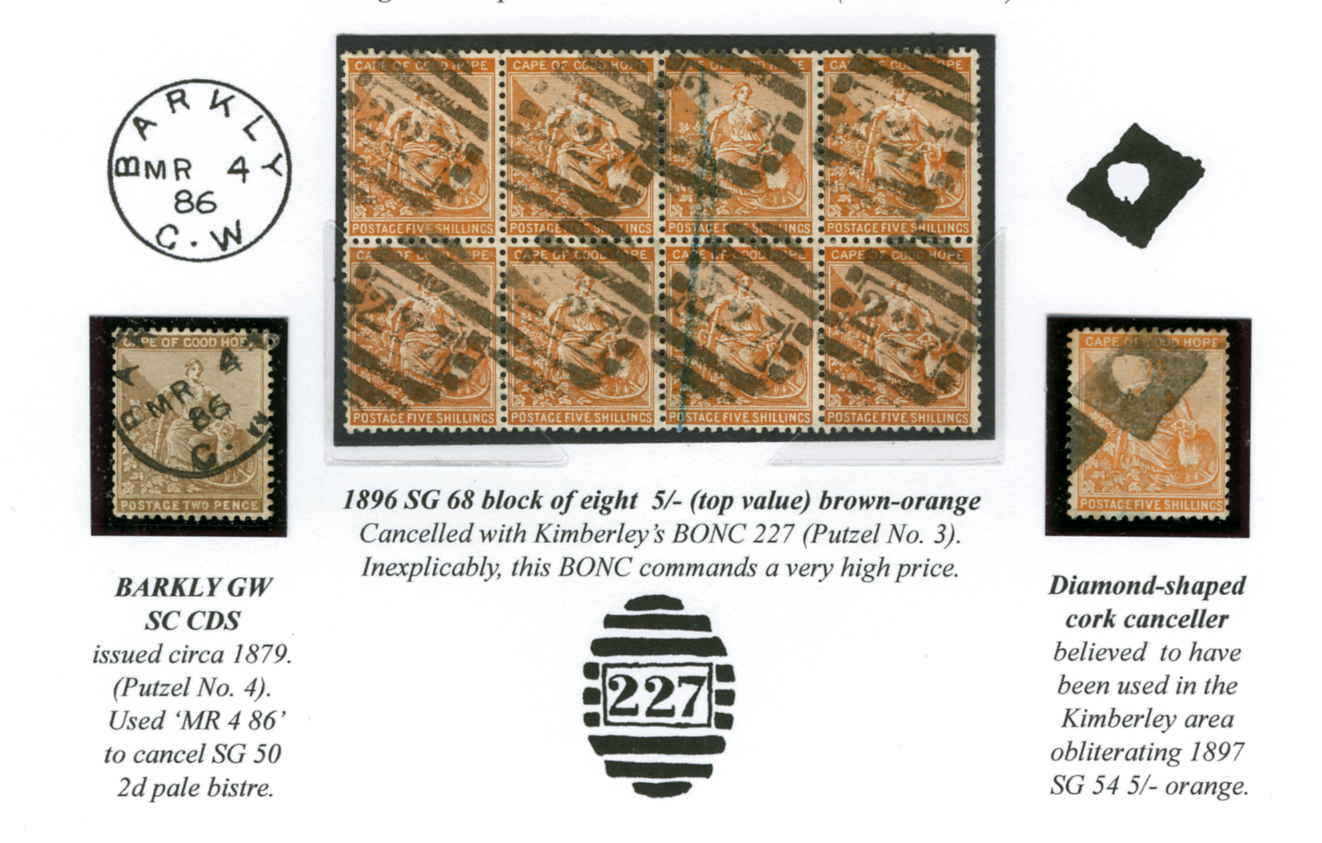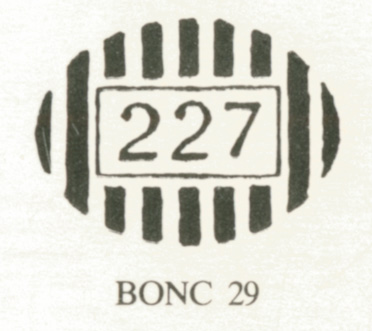BONCs: How to Display them.
Quote from Steve on December 2, 2023, 6:52 pmSome months ago I was asked by a new member "what's the best way to display a collection of Cape BONCs?". The enquiry came at a time when I was busy so I put it on the back-burner. (Anyone here old enough to remember one of those?)
Recently I began sifting through my accumulation, sorting the wheat from the chaff and in the process I put my better BONCs (Barred Oval Numeral Cancellers) into a separate stockbook in preparation for mounting them in a display .... 'one day'. That day may soon arrive. It is coming on Christmas and the weather outside is spiteful. As I will need an indoor winter project during the dark months ahead, this article is me thinking aloud about how best to start my BONC display. Sorry if this is a stream of unconsciousness!
A Bit about BONCs
A perusal of many old SAP (The South Philatelist) from the 1970/80s reveals that the term 'BONC' is relatively new. According to Peter Thy, the word 'BONC' is now "ubiquitous in world philately", coined when Franco Frescura was Editor of the 'Post Office Stone', the Quarterly Journal of the Postmark and Postal History Society of Southern Africa, 1981 -84. Thy says the "onomatopeic acronym was invented by Frescura and Nethersole to describe the Cape's barred oval numeral cancellers". (The Springbok Vol 54/1, Page 30, Jan/Mar 2006). Indeed, my re-reading of ancient SAPs reveals no use of 'BONCs' before the 1980s. Robert Goldblatt presumably picked the term up in the Post Office Stone and used it in his popular reference work of 1984, 'The Postmarks of the Cape of Good Hope'.
The BONC was introduced in Cape Town and in PE in 1864 as an obliterator for use on the new rectangular stamps.
I include the above, missing a 3d stamp, top left, here because of the difficulty of finding genuine 1864/65 BONCS used on cover. It is imperfect, I know, BUT it shows arguably genuine use of the original 1864 Thick Nine Bar BONC in the Cape Town GPO in 1868. Sent from Cape Town on 'OC 17 68' at the 1/ 4d rate (outer frame line issue) via London '21 NO 68' to Berlin, Prussia, the applied Cape Town BONC 1 is doing what it was intended to do, obliterate stamps in conjunction with the Single Circle datestamp of 1864.
The display sheet below contains examples of BONC's on Cape Triangles which I made up many years ago. As one of the great classic stamps a few BONCs on Cape Triangles will add extra interest to your display. (After a little BONC History, of course!)
CoGH BONC Reference Works
All good displays beautify knowledge using items of philately, postal history and ephemera. Knowledge is found in philatelic reference works. There are popular works by well-known postal historians who reference BONCs as a field of study. These include:
- Gilbert Allis' (Cape of Good Hope - Its Postal History & Postage Stamps'. 1930).
- A. A. Jurgens (Handstruck Letter Stamps of the Cape of Good Hope & Postmarks 1792 to 1910'. 1943).
- Robert Goldblatt (Postmarks of the Cape of Good Hope. 1984.)
- Ralph Putzel (The Postmartks of South Africa and Forner States and Colonies. 1994.)
- David Mordant (Barred Oval Numeral Cancellers of the Cape of Good Hope 1863-1963. 2020).
- Franco Frescura and Alex Visser. (Revised Listing of POs & Postal Markings of the CoGH 1792 -1910. 2021).
I have used all of the above reference works except Allis'. Based on my experience I offer the following advice.
Histories are built up from memory, reports, documents and other people's work. The fist book on Cape philately was Gilbert Allis' 'Cape of Good Hope - Its Postal History & Postage Stamps', (published by Stanley Gibbons, Ltd. 1930). The second book on the subject was by Allis' great and bitter rival, A. A. Jurgens, author of 'The Handstruck Letter Stamps of the Cape of Good Hope from 1792 to 1853 and the Postmarks from 1853 to 1910'. Jurgens was obsessed with Allis and determined to overtake him in all things, even if it meant fabricating history. In Jurgens' defence, his section on 'The Numeral Defacing Stamp of 1864' is impressively detailed and interesting.
One criticism of Robert Goldblatt's (Postmarks of the Cape of Good Hope. 1984) is that he drew too heavily on Jurgens' work which many today believe was in part a flawed and falsified study. Indeed, Goldblatt uses Jurgens' misleading example of Cradock and East London's BONC's to highlight the indiscriminate distribution of the BONC numerals. I have used Goldblatt's book for almost 20 years and now wish I had stopped using it years ago. Nevertheless, because it is simple and straightforward it remains popular, selling regularly in auction. It also provides a good and accessible overview of Cape postmarks, especially pre and post-adhesives. However, while its section on BONCs is well-illustrated, its advice is old and dated, its coverage incomplete and sometimes even downright wrong.
On the plus side, Goldblatt includes both an alphabetic and a numeric list of BONCs, neither of which is up-to-date. If you are truly interested in BONCs and have an enquiring mind, this book will raise more annoying questions than provide answers. Ultimately its section on BONCs is a time-consuming distraction, the equivalent of driving from Cape Town to Jo'burg via Windhoek. Why take this route when there is a better, up-to-date alternative that is free to download and which will give you more answers in half the time?
Because Putzel and his associates stood on Goldblatt's shoulders their work in the 1990s drew heavily on his influences from 1984. However, while Putzel is arguably South Africa's senior postal historian, you will not find his ten volumes of South African postmarks casting a bright light on a BONC breakthrough. His alphabetic listing of South African postmarks is only useful in showing examples of BONCs and the datestamps used in conjunction with them, an area which Goldblatt unhelpfully muddied with broad generalisations.
Unlike Putzel, but like Jurgens and Goldblatt, Frescura / Visser document Cape postmarks only. Rather than show an example of every Cape postmark, they use a typology system showing one illustration of each postmark type and a text abbreviation for it in lists of handstamps used in each post office. I have a sense of unease that this has lead them to lump distinctively different BONC varieties together. (Jurgens describes 32 'distinct types' while Goldblatt illustrates 18 1864/65 Thick Nine Bar BONCs. Frescura / Visser illustrate just six BONCs and one Duplex cancellerl in total!). I am not a fan of their typology sytem. I like to see examples of postmarks wherever possible. However, the best and most useful feature of their work is their documentation of ER (Earliest Recorded) and LR (Last Recorded) dates of use of every postmark. This includes all Cape postmarks, not just BONCs. This makes their work a valuable resource. Their worst omission is the absence of a numerical BONC listing. While their system allows us to see which BONC town A, B or C used, it is impossible to find where BONC 187, etc., was used without tiresomely trawling through the entire book. Their publication is free to download from the PFSA / Resource website.
***** OUR FIVE STAR RECOMMENDATION *****
David Mordant's 'Barred Oval Numeral Cancellers of the Cape of Good Hope 1863-1963', (2020)This dedicated work is the most useful CoGH BONC reference available to postal historians. The dead hands of past postal historians have not impressed themselves on this fresh look at BONCs. Mordant's work has all the best features of the other books while avoiding their shortcomings. It contains illustrations, charts and useful advice, as well as the vital alphabetic and numeric listings that let you easily and quickly find which BONC towns A-Z used and or where BONC 187, etc., was used. Written in 2020 it is reasonably up-to-date in terms of recent discoveries (with the possibility of another update in the pipeline). It tells us that BONC 8, for many years unrecorded, was used at Marico in the Transvaal in 1878, then under British control. It is worth noting that Frescura / Visser's book does not show this, presumably because it is dedicated to the CAPE specifically, not to BONCs used generally outside of the Cape. It suggests that when a postmaster transferred to another town, he/she possibly took 'their' BONC with them, resulting in dual BONC usage. It is the only publication I know of bold enough to show that just some 50 BONCs were distributed in 1864/65, a revelation that feels like floating on clouds after ploughing through Goldblatt's impossibly misleading morass of some 500 BONCs distributed by 1865. Best of all, it is FREE from this website, downloadable as a printable PDF. (See Below). Its acquisition is the best way to start an up-to-date BONC display free of historic misinformation.
I used Goldblatt and got much about BONCs wrong. Don't make my mistake!
https://southafricanphilatelyclub.com/cape-of-good-hope-stamps-and-postal-history
Some months ago I was asked by a new member "what's the best way to display a collection of Cape BONCs?". The enquiry came at a time when I was busy so I put it on the back-burner. (Anyone here old enough to remember one of those?)
Recently I began sifting through my accumulation, sorting the wheat from the chaff and in the process I put my better BONCs (Barred Oval Numeral Cancellers) into a separate stockbook in preparation for mounting them in a display .... 'one day'. That day may soon arrive. It is coming on Christmas and the weather outside is spiteful. As I will need an indoor winter project during the dark months ahead, this article is me thinking aloud about how best to start my BONC display. Sorry if this is a stream of unconsciousness!
A Bit about BONCs
A perusal of many old SAP (The South Philatelist) from the 1970/80s reveals that the term 'BONC' is relatively new. According to Peter Thy, the word 'BONC' is now "ubiquitous in world philately", coined when Franco Frescura was Editor of the 'Post Office Stone', the Quarterly Journal of the Postmark and Postal History Society of Southern Africa, 1981 -84. Thy says the "onomatopeic acronym was invented by Frescura and Nethersole to describe the Cape's barred oval numeral cancellers". (The Springbok Vol 54/1, Page 30, Jan/Mar 2006). Indeed, my re-reading of ancient SAPs reveals no use of 'BONCs' before the 1980s. Robert Goldblatt presumably picked the term up in the Post Office Stone and used it in his popular reference work of 1984, 'The Postmarks of the Cape of Good Hope'.
The BONC was introduced in Cape Town and in PE in 1864 as an obliterator for use on the new rectangular stamps.
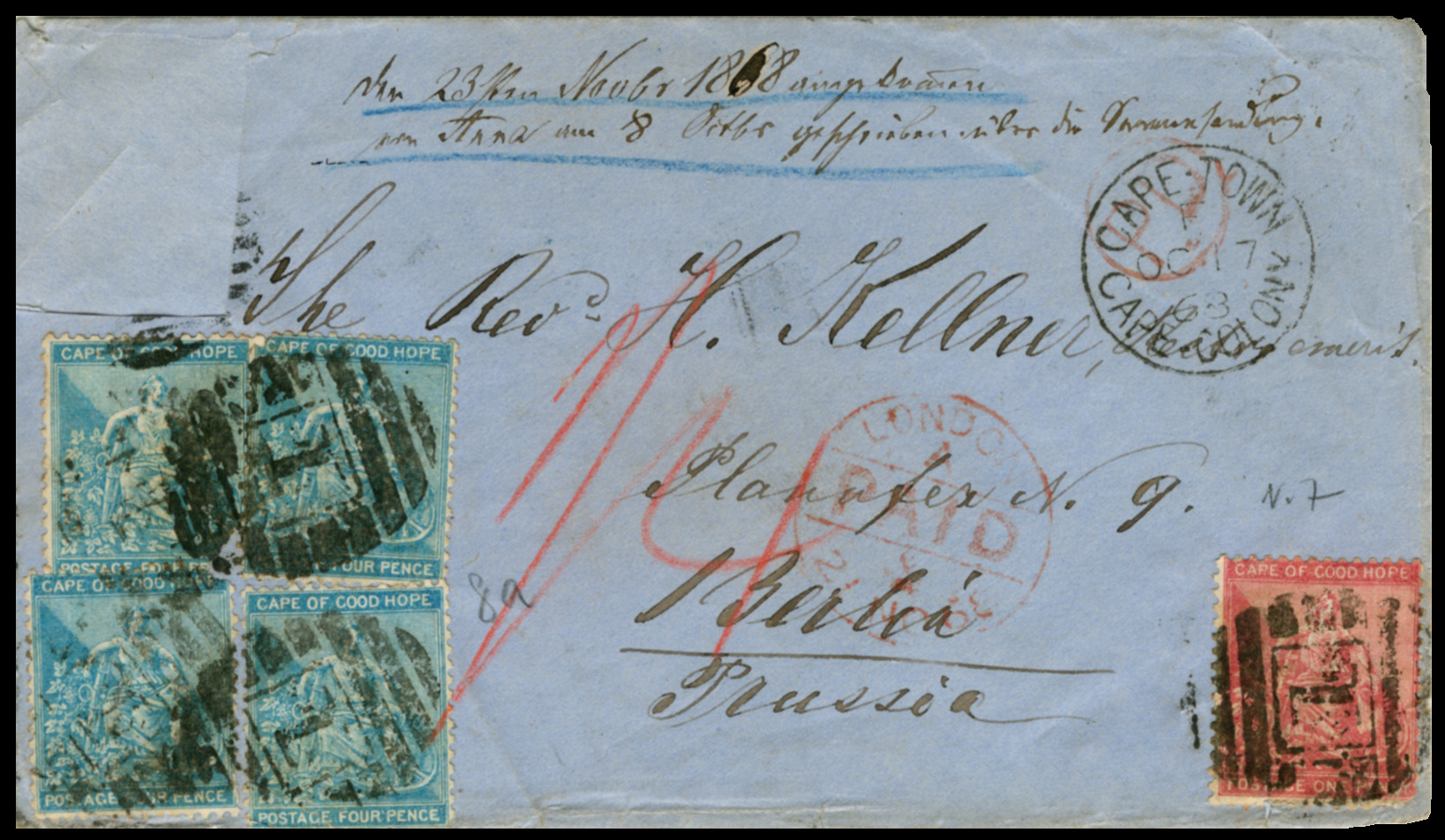
I include the above, missing a 3d stamp, top left, here because of the difficulty of finding genuine 1864/65 BONCS used on cover. It is imperfect, I know, BUT it shows arguably genuine use of the original 1864 Thick Nine Bar BONC in the Cape Town GPO in 1868. Sent from Cape Town on 'OC 17 68' at the 1/ 4d rate (outer frame line issue) via London '21 NO 68' to Berlin, Prussia, the applied Cape Town BONC 1 is doing what it was intended to do, obliterate stamps in conjunction with the Single Circle datestamp of 1864.
The display sheet below contains examples of BONC's on Cape Triangles which I made up many years ago. As one of the great classic stamps a few BONCs on Cape Triangles will add extra interest to your display. (After a little BONC History, of course!)
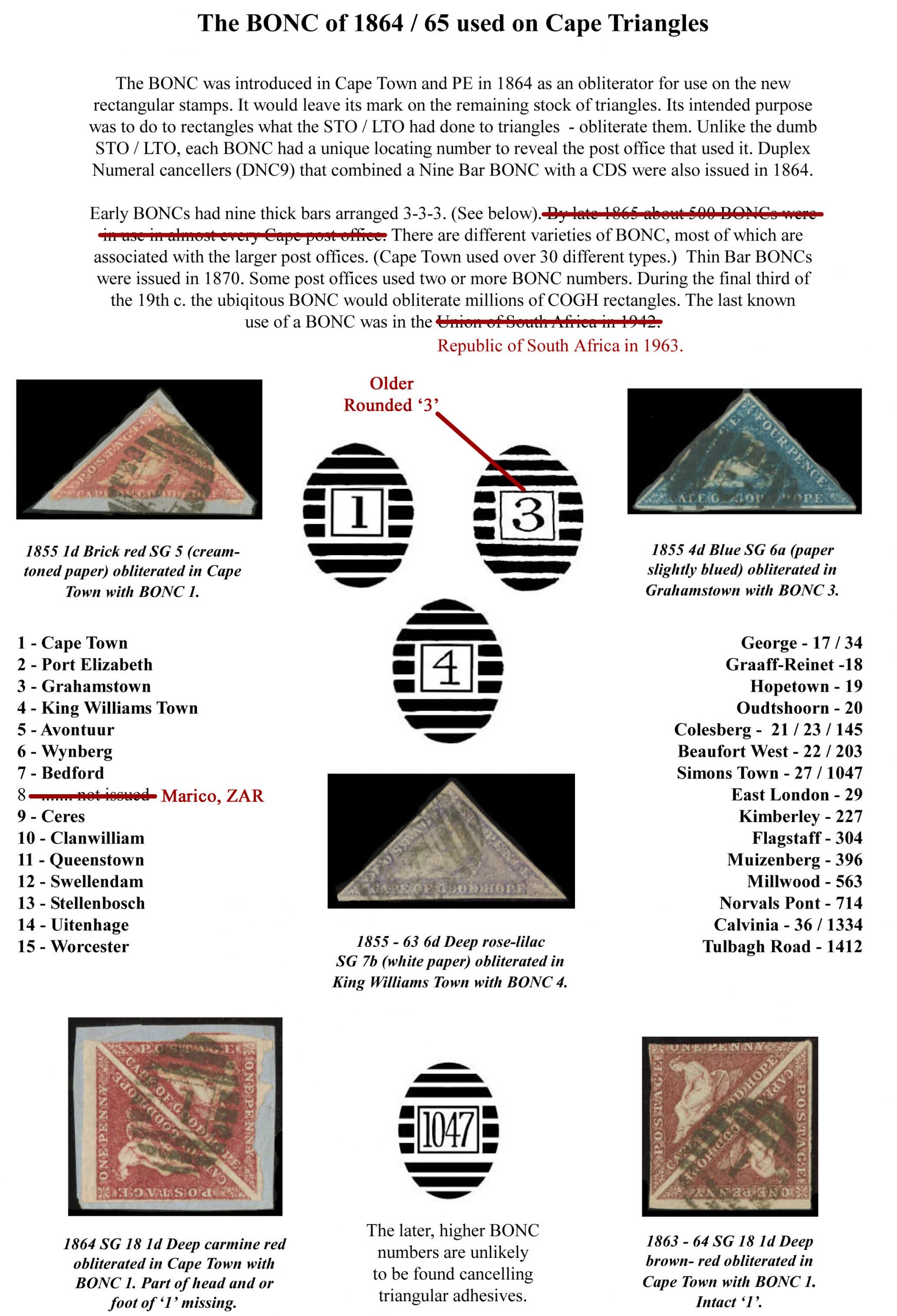
CoGH BONC Reference Works
All good displays beautify knowledge using items of philately, postal history and ephemera. Knowledge is found in philatelic reference works. There are popular works by well-known postal historians who reference BONCs as a field of study. These include:
- Gilbert Allis' (Cape of Good Hope - Its Postal History & Postage Stamps'. 1930).
- A. A. Jurgens (Handstruck Letter Stamps of the Cape of Good Hope & Postmarks 1792 to 1910'. 1943).
- Robert Goldblatt (Postmarks of the Cape of Good Hope. 1984.)
- Ralph Putzel (The Postmartks of South Africa and Forner States and Colonies. 1994.)
- David Mordant (Barred Oval Numeral Cancellers of the Cape of Good Hope 1863-1963. 2020).
- Franco Frescura and Alex Visser. (Revised Listing of POs & Postal Markings of the CoGH 1792 -1910. 2021).
I have used all of the above reference works except Allis'. Based on my experience I offer the following advice.
Histories are built up from memory, reports, documents and other people's work. The fist book on Cape philately was Gilbert Allis' 'Cape of Good Hope - Its Postal History & Postage Stamps', (published by Stanley Gibbons, Ltd. 1930). The second book on the subject was by Allis' great and bitter rival, A. A. Jurgens, author of 'The Handstruck Letter Stamps of the Cape of Good Hope from 1792 to 1853 and the Postmarks from 1853 to 1910'. Jurgens was obsessed with Allis and determined to overtake him in all things, even if it meant fabricating history. In Jurgens' defence, his section on 'The Numeral Defacing Stamp of 1864' is impressively detailed and interesting.
One criticism of Robert Goldblatt's (Postmarks of the Cape of Good Hope. 1984) is that he drew too heavily on Jurgens' work which many today believe was in part a flawed and falsified study. Indeed, Goldblatt uses Jurgens' misleading example of Cradock and East London's BONC's to highlight the indiscriminate distribution of the BONC numerals. I have used Goldblatt's book for almost 20 years and now wish I had stopped using it years ago. Nevertheless, because it is simple and straightforward it remains popular, selling regularly in auction. It also provides a good and accessible overview of Cape postmarks, especially pre and post-adhesives. However, while its section on BONCs is well-illustrated, its advice is old and dated, its coverage incomplete and sometimes even downright wrong.
On the plus side, Goldblatt includes both an alphabetic and a numeric list of BONCs, neither of which is up-to-date. If you are truly interested in BONCs and have an enquiring mind, this book will raise more annoying questions than provide answers. Ultimately its section on BONCs is a time-consuming distraction, the equivalent of driving from Cape Town to Jo'burg via Windhoek. Why take this route when there is a better, up-to-date alternative that is free to download and which will give you more answers in half the time?
Because Putzel and his associates stood on Goldblatt's shoulders their work in the 1990s drew heavily on his influences from 1984. However, while Putzel is arguably South Africa's senior postal historian, you will not find his ten volumes of South African postmarks casting a bright light on a BONC breakthrough. His alphabetic listing of South African postmarks is only useful in showing examples of BONCs and the datestamps used in conjunction with them, an area which Goldblatt unhelpfully muddied with broad generalisations.
Unlike Putzel, but like Jurgens and Goldblatt, Frescura / Visser document Cape postmarks only. Rather than show an example of every Cape postmark, they use a typology system showing one illustration of each postmark type and a text abbreviation for it in lists of handstamps used in each post office. I have a sense of unease that this has lead them to lump distinctively different BONC varieties together. (Jurgens describes 32 'distinct types' while Goldblatt illustrates 18 1864/65 Thick Nine Bar BONCs. Frescura / Visser illustrate just six BONCs and one Duplex cancellerl in total!). I am not a fan of their typology sytem. I like to see examples of postmarks wherever possible. However, the best and most useful feature of their work is their documentation of ER (Earliest Recorded) and LR (Last Recorded) dates of use of every postmark. This includes all Cape postmarks, not just BONCs. This makes their work a valuable resource. Their worst omission is the absence of a numerical BONC listing. While their system allows us to see which BONC town A, B or C used, it is impossible to find where BONC 187, etc., was used without tiresomely trawling through the entire book. Their publication is free to download from the PFSA / Resource website.
***** OUR FIVE STAR RECOMMENDATION *****
David Mordant's 'Barred Oval Numeral Cancellers of the Cape of Good Hope 1863-1963', (2020)
This dedicated work is the most useful CoGH BONC reference available to postal historians. The dead hands of past postal historians have not impressed themselves on this fresh look at BONCs. Mordant's work has all the best features of the other books while avoiding their shortcomings. It contains illustrations, charts and useful advice, as well as the vital alphabetic and numeric listings that let you easily and quickly find which BONC towns A-Z used and or where BONC 187, etc., was used. Written in 2020 it is reasonably up-to-date in terms of recent discoveries (with the possibility of another update in the pipeline). It tells us that BONC 8, for many years unrecorded, was used at Marico in the Transvaal in 1878, then under British control. It is worth noting that Frescura / Visser's book does not show this, presumably because it is dedicated to the CAPE specifically, not to BONCs used generally outside of the Cape. It suggests that when a postmaster transferred to another town, he/she possibly took 'their' BONC with them, resulting in dual BONC usage. It is the only publication I know of bold enough to show that just some 50 BONCs were distributed in 1864/65, a revelation that feels like floating on clouds after ploughing through Goldblatt's impossibly misleading morass of some 500 BONCs distributed by 1865. Best of all, it is FREE from this website, downloadable as a printable PDF. (See Below). Its acquisition is the best way to start an up-to-date BONC display free of historic misinformation.
I used Goldblatt and got much about BONCs wrong. Don't make my mistake!
https://southafricanphilatelyclub.com/cape-of-good-hope-stamps-and-postal-history
Quote from Steve on December 3, 2023, 1:38 pmEvolution of the Cape BONC
As ever, I recommend that we begin at the beginning with the CoGH BONC's British antecedents.
This subject deserves to be illustrated with drawn examples - or better real ones dependent on your budget - of those British obliterators whose design lead to the colonial BONC. Below, I attach Maurice Barette's 'Evolution of Species in British Postmarks' taken from his wonderful 'LONDON FANCY GEOMETRIC POSTMARKS (1994)'. I have enclosed a section on the right that shows BN (Barred Numerals 15 & 612) evolving into a Duplex cancelle which included a BONC. This could be adapted for your Cape / southern African BONC display.
Usually, when displaying the stamps of a country or a place it is suggested that you include a Map of where it is. In the case of Cape BONCs this is more easily achieved as a broad generalisation ie. a map of the Cape with its main towns (and their BONC numbers) rather than attempting anything more specific, like every town, which is an impossibilty.
As the Cape Post Office took its lead in all things postal from Great Britain, specifically England, the story of the CoGH BONC begins there. The Penny Black stamp, the world's first adhesive postage stamp, went on sale in Great Britain on 6th May 1840. These were largely cancelled with the aesthetically pleasing but not always efficient Maltese Cross obliterator. After four years of adding delightful cancels to Penny Blacks the Maltese Cross obliterator was replaced with the BN (Barred Numeral) canceller. Its purpose was to prevent any chance of stamps being re-used. These thick and heavily inked postmarks are often called 'killer cancellers' by stamp collectors. See BN 15 & 612 below, bottom right.
The Uniform Penny Post had been introduced throughout Great Britain and Ireland on 10th January 1840. (Variously 1860-1864 at the Cape.) Safe, quick and relatively low cost, this popular form of communication led to an increase in the number of letters posted, However, this mail required double-strking in the post office, once for obliteration of the stamp and again for town and date-stamping with a second device. As the volumes of mail grew, double striking a letter with two different cancellers was seen to be time-consuming and inefficient.
BN cancellers were introduced to English and Welsh provincial post offices on 1st May 1844 and in the London Inland office on 17th May. Each region had its own distinct design difference. Ireland used a diamond, Scotland a square, England and Wales an oval.
Interestingly, the above London District canceller was an oval with a numeral in a circle while the London Inland Section, top above, used an oval with a numeral in a diamond.
The first Cape BONC evolved from these with an oval design of 9 horizontal bars surrounding a numeral within a rectangle. Below is an early-ish Hull duplex canceller with single circle datestamp BN 383 attached.
The solution was a Duplex handstamp which combined a datestamp and BN in a single canceller. These were introduced in Great Britain between February 1853 to March 1854. See the examples BN 659, 383,75 &53 in Maurice Barette's 'Evolution of Species in British Postmarks'. Eventually, the English Duplex datestamp would include a BONC similar to those in exclusive use in Cape Town and Port Elizabeth from 1853 onwards. See Leicester's Duplex 449 of 1870, (Barette), and my two examples on cover, above and below.
Queen Victoria granted the Cape its first Parliament in 1853. Until this point all decisions affecting the Cape, like postal rates, were subject to the laws of the British Parliament in England. For this reason, the Cape Post Office followed English postal practices.
Introduction of CoGH Triangular Stamps: 1853
On 1st September 1853 the Cape Post Office introduced its long-awaited triangular postage stamps. In doing so, it drew heavily on the British experience with the Penny Black and its cancellers. In particular, it worried about the prospect of postal revenues being lost if stamps were re-used. To counter this, the Cape Post Office made wide-spread use of triangular obliterators to cancel its new adhesives.
Introduction of Cape BONCs: 1864/65
A British-style BONC handstamp would not be introduced until 1864 with the issue of the Cape's first rectangular 'Hope' seated stamps. The BONC would replace many CGH triangular obliterators while fulfilling the same role as a' killer canceller' but with the added advantage of including a numeral that identified the dispatching post office. A small number of new single circle 'CAPE COLONY' datestampa accompanied the BONC's introduction. Their purpose was to date covers on dispatch while the BONC obliterated the stamp.
Numbers of BONCs issued: 1864/65
While attempting to understand the introduction of the BONC at the Cape I turned to Goldblatt for the simplicity of his advice and the usefulness of his illustrations. This was a mistake. He states that a BONC was first issued "in 1864 and by the following year, the cancellers were well distributed throughout the colony .... by 1865, about 500 Post Offices and postal agencies had been issued with the "Thick Bar" Numeral Canceller of 1864". From this it appears Goldblatt is saying that the first issue of about 500 Thick Nine Bar BONCs was made by end-1865. The reality is that it was less than a tenth of this number, about 39 BONCs (Mordant).
Goldblatt says the BONC "was a dumb canceller, intended to be used in conjunction with with one or another of the circular datestamps incorporating the name of the post office from which it was dispatched". Regulations required that the stamp be obliterated with the BONC and that an existing datestamp be clearly applied on the cover. This was often ignored. As per British practice, the BONC was intended to obliterate the postage stamp while a second strike of a datestamp added the town name as well as the date and time of dispatch. As time went by and mail volumes grew at the Cape the need to strike a letter twice became a source of annoyance among some colonial postal staff once they began to see increasing volumes of overseas mail cancelled with a datestamp.
Proving Covers / Pieces
As each town received an individual BONC numeral, it is possible to prove the numeral used by referencing the town's datestamp. Covers that bear both a BONC and a dispatch datestamp are called 'proving covers'. In any display they will serve to show how BONCs are provenanced. While the rarer uncommon proving covers are usually expensive to buy, there are many more common ones that are not. IMO, every display of BONCs should include some 'proving covers. I show some common and reasonably affordable ones below.
The Cape Post Office's listings of which town(s) used what BONC numeral(s) are incomplete. While BONC numbers are recorded up to 2001, not all BONCs known issued have a town associated with them. Great work has been done by specialists like Frescura and Mordant in adding numerals to a particular town but many BONCs remain unidentified. According to Mordant, 1427 BONCs are recorded issued among numerals up to 2001. Of these 57.5% of BONCs were identified with an allocated town post office by 2020.
The Uncollectable BONC
In the 1930s in South Africa few people collected postmarks. Among those who did, BONCs came last. Almost no-one valued them. It was possible to pick them up for next to nothing. Over time that changed. To see how far the recording of BONCs has come, see Mordant's 'Barred Oval Numeral Cancellers of the Cape of Good Hope 1863-1963' on this site. You can save this as a PDF and print it out and use it as a reference if need be. If you have proving pieces for some of David's 'gaps', please send him a scan of your example. It is by getting involved and sharing information that our hobby moves forward to a broader understanding of the subject. Thank you.
Maurice Barrette FRPS's wonderful 'London Fancy Geometric Postmarks' is more than just a treatise on the 'Squared Circle Datestamp', it is also a very entertaining read. Here is an extract from the Forward. "Like species studied by paleontologists, handstamps gave birth to lines of descent, by recutting of dies and their evolution can be followed from the original proof to the final design used in the end. As in Paleontology, some "fossils" may still be unrecorded at the origin of some lines, and there may be "missing links" within some other descents..."
Evolution of the Cape BONC
As ever, I recommend that we begin at the beginning with the CoGH BONC's British antecedents.
This subject deserves to be illustrated with drawn examples - or better real ones dependent on your budget - of those British obliterators whose design lead to the colonial BONC. Below, I attach Maurice Barette's 'Evolution of Species in British Postmarks' taken from his wonderful 'LONDON FANCY GEOMETRIC POSTMARKS (1994)'. I have enclosed a section on the right that shows BN (Barred Numerals 15 & 612) evolving into a Duplex cancelle which included a BONC. This could be adapted for your Cape / southern African BONC display.
Usually, when displaying the stamps of a country or a place it is suggested that you include a Map of where it is. In the case of Cape BONCs this is more easily achieved as a broad generalisation ie. a map of the Cape with its main towns (and their BONC numbers) rather than attempting anything more specific, like every town, which is an impossibilty.
As the Cape Post Office took its lead in all things postal from Great Britain, specifically England, the story of the CoGH BONC begins there. The Penny Black stamp, the world's first adhesive postage stamp, went on sale in Great Britain on 6th May 1840. These were largely cancelled with the aesthetically pleasing but not always efficient Maltese Cross obliterator. After four years of adding delightful cancels to Penny Blacks the Maltese Cross obliterator was replaced with the BN (Barred Numeral) canceller. Its purpose was to prevent any chance of stamps being re-used. These thick and heavily inked postmarks are often called 'killer cancellers' by stamp collectors. See BN 15 & 612 below, bottom right.
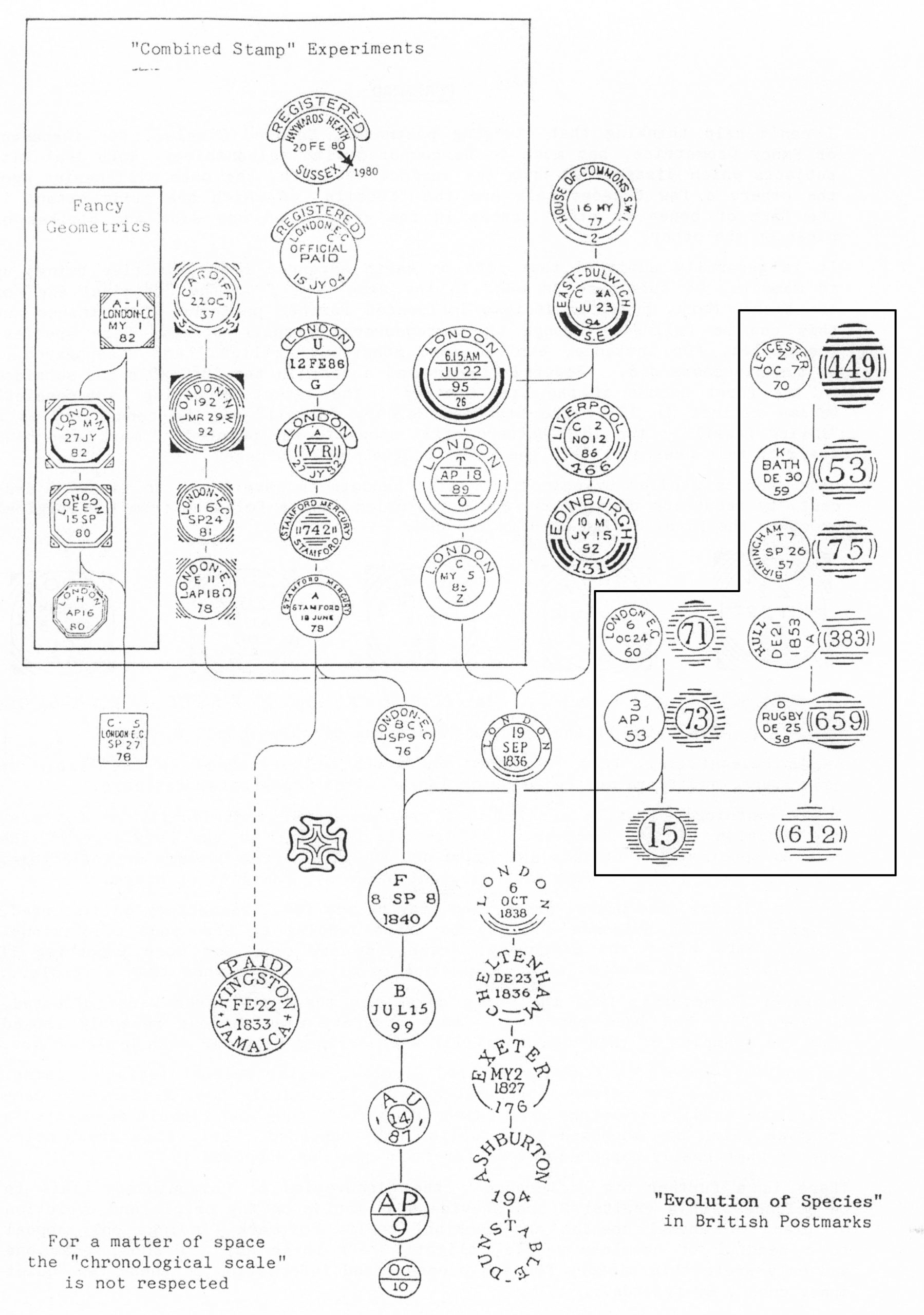
The Uniform Penny Post had been introduced throughout Great Britain and Ireland on 10th January 1840. (Variously 1860-1864 at the Cape.) Safe, quick and relatively low cost, this popular form of communication led to an increase in the number of letters posted, However, this mail required double-strking in the post office, once for obliteration of the stamp and again for town and date-stamping with a second device. As the volumes of mail grew, double striking a letter with two different cancellers was seen to be time-consuming and inefficient.
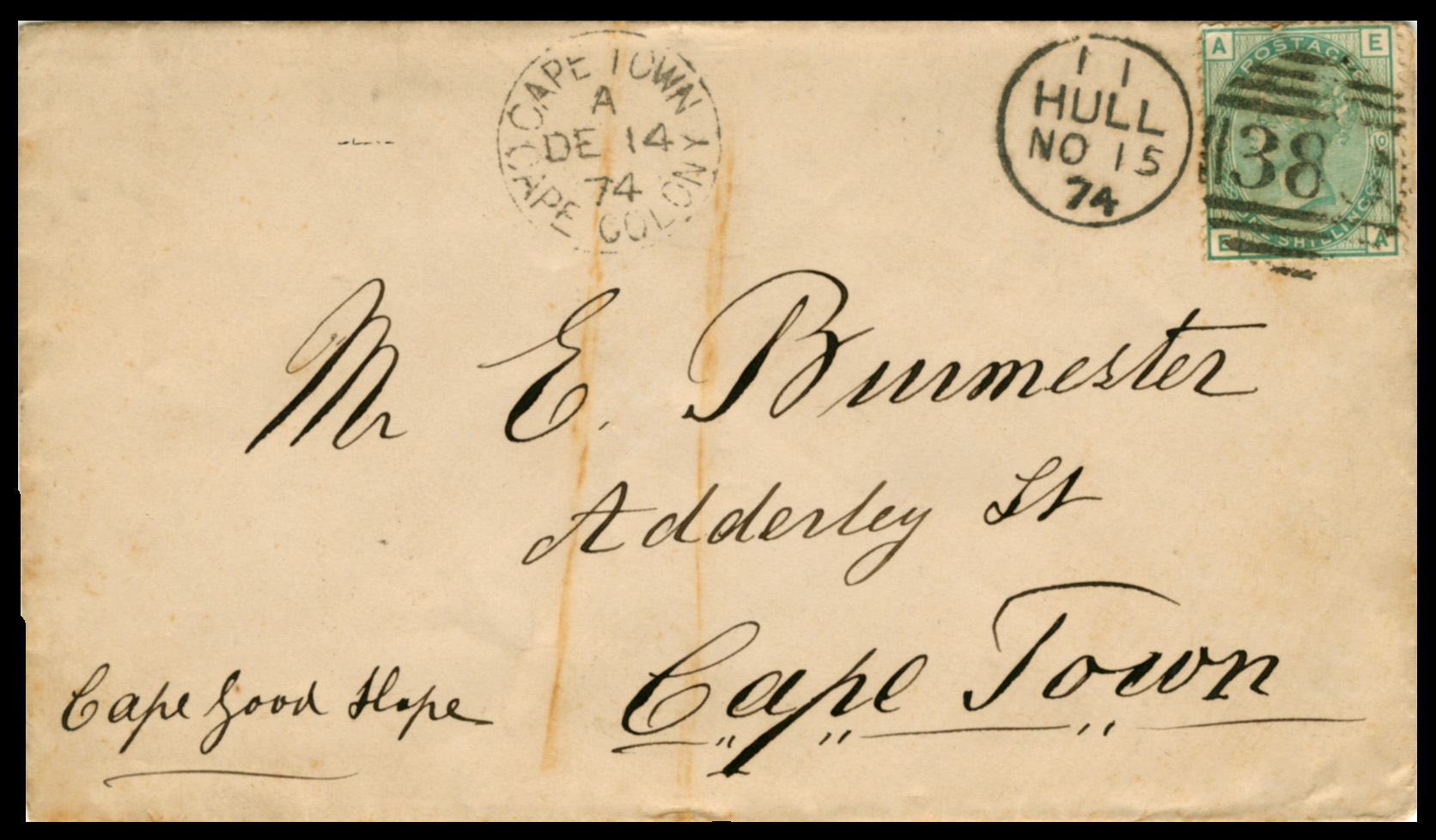
BN cancellers were introduced to English and Welsh provincial post offices on 1st May 1844 and in the London Inland office on 17th May. Each region had its own distinct design difference. Ireland used a diamond, Scotland a square, England and Wales an oval.
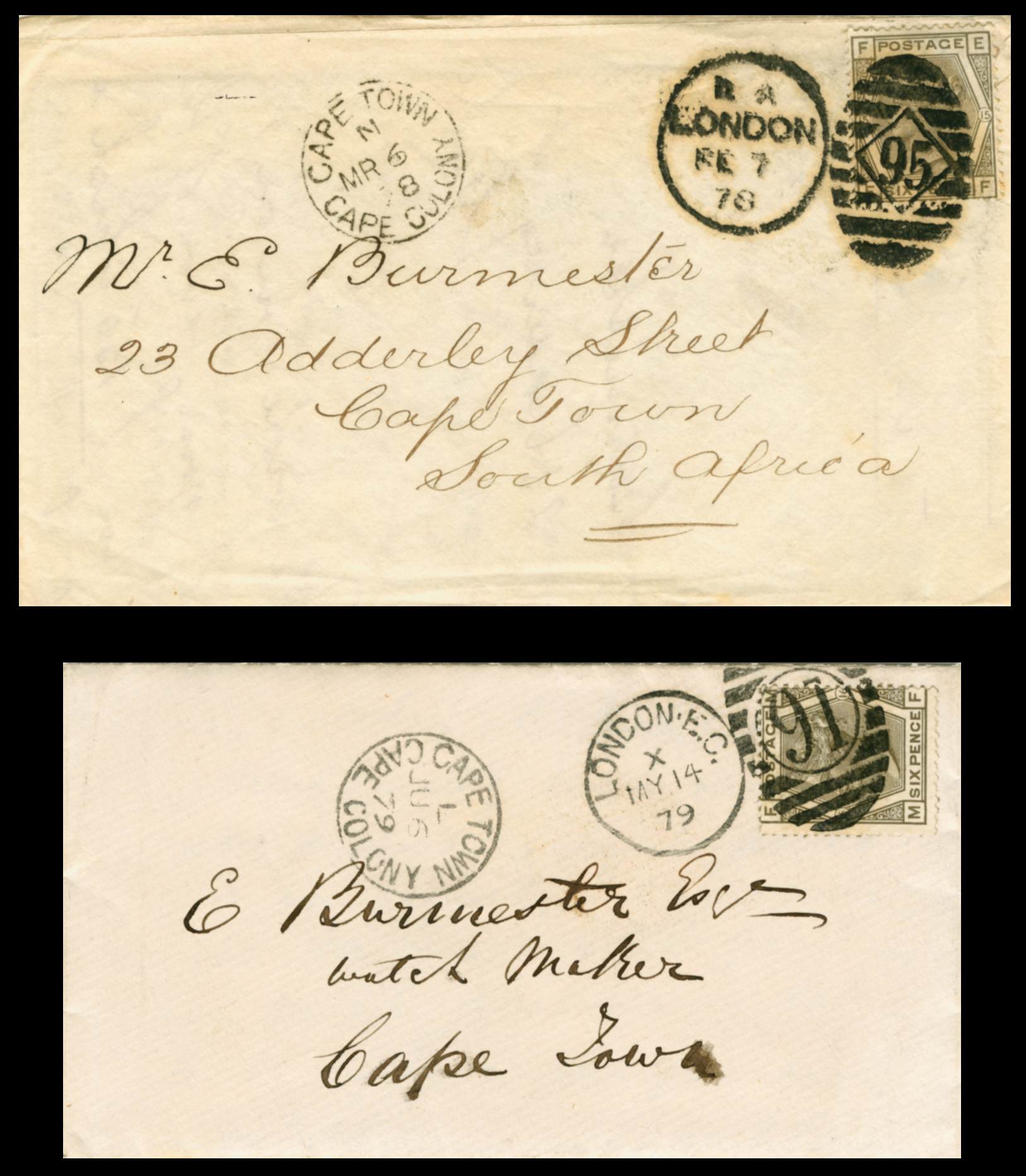
Interestingly, the above London District canceller was an oval with a numeral in a circle while the London Inland Section, top above, used an oval with a numeral in a diamond.
The first Cape BONC evolved from these with an oval design of 9 horizontal bars surrounding a numeral within a rectangle. Below is an early-ish Hull duplex canceller with single circle datestamp BN 383 attached.
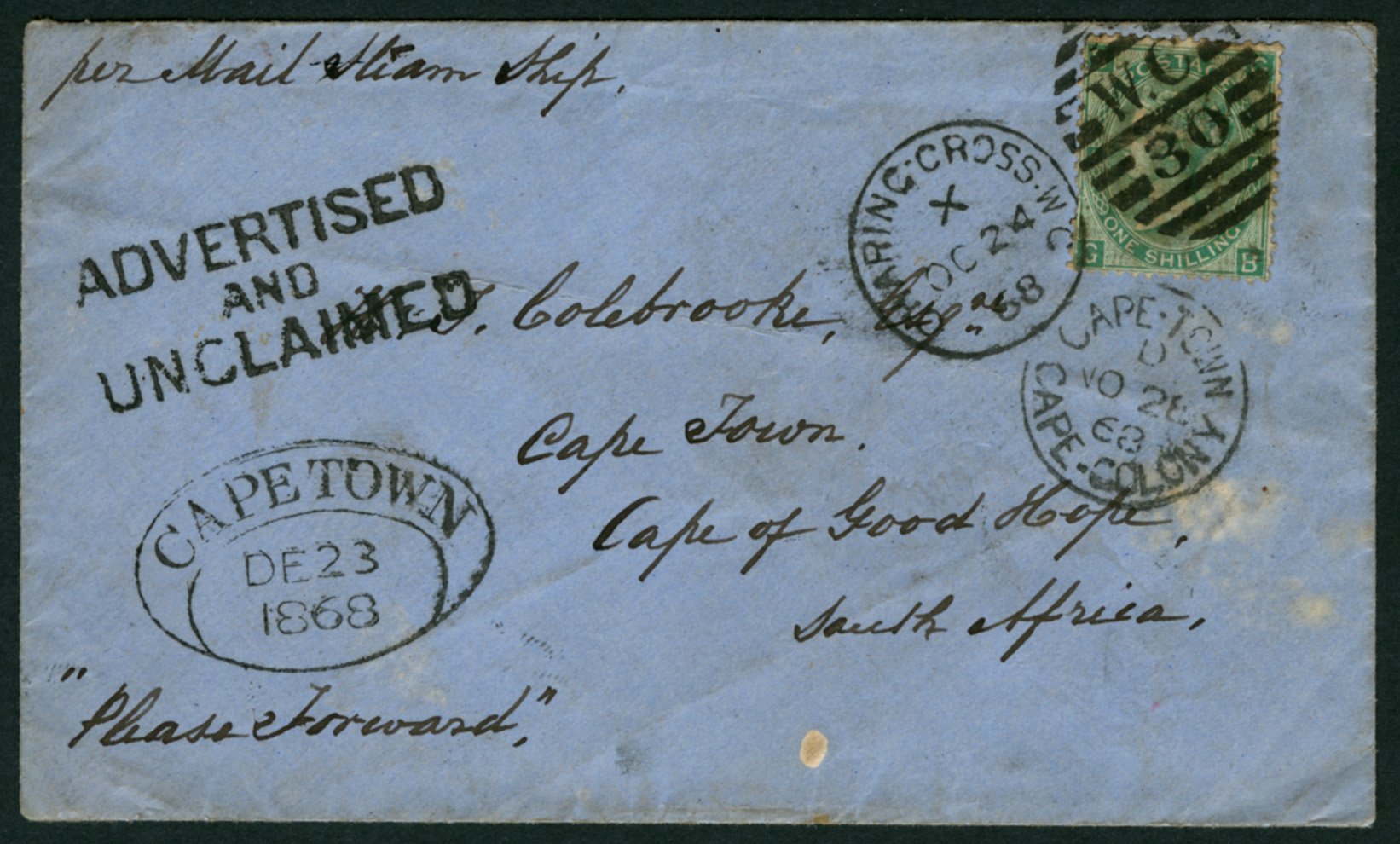
The solution was a Duplex handstamp which combined a datestamp and BN in a single canceller. These were introduced in Great Britain between February 1853 to March 1854. See the examples BN 659, 383,75 &53 in Maurice Barette's 'Evolution of Species in British Postmarks'. Eventually, the English Duplex datestamp would include a BONC similar to those in exclusive use in Cape Town and Port Elizabeth from 1853 onwards. See Leicester's Duplex 449 of 1870, (Barette), and my two examples on cover, above and below.
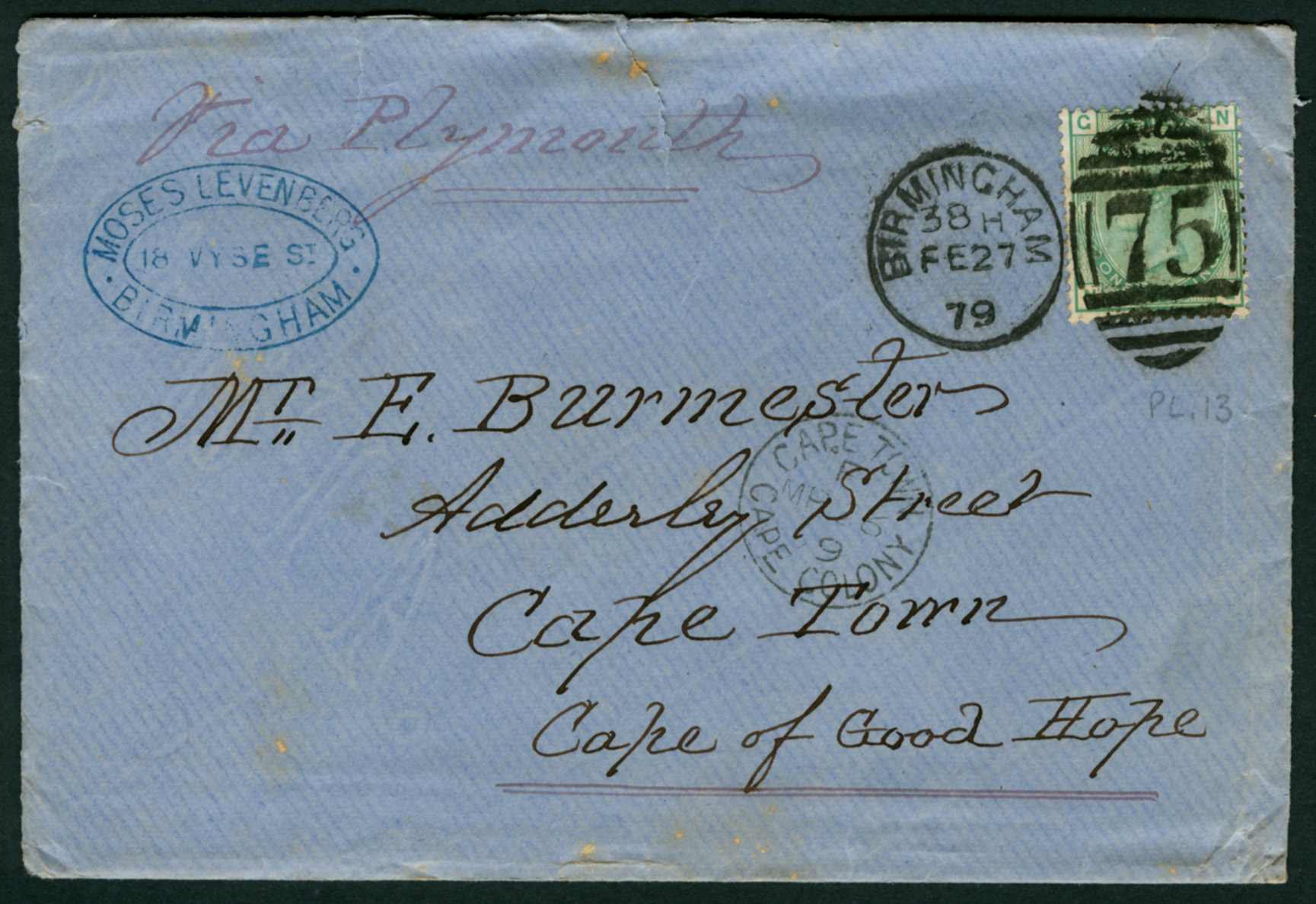
Queen Victoria granted the Cape its first Parliament in 1853. Until this point all decisions affecting the Cape, like postal rates, were subject to the laws of the British Parliament in England. For this reason, the Cape Post Office followed English postal practices.
Introduction of CoGH Triangular Stamps: 1853
On 1st September 1853 the Cape Post Office introduced its long-awaited triangular postage stamps. In doing so, it drew heavily on the British experience with the Penny Black and its cancellers. In particular, it worried about the prospect of postal revenues being lost if stamps were re-used. To counter this, the Cape Post Office made wide-spread use of triangular obliterators to cancel its new adhesives.
Introduction of Cape BONCs: 1864/65
A British-style BONC handstamp would not be introduced until 1864 with the issue of the Cape's first rectangular 'Hope' seated stamps. The BONC would replace many CGH triangular obliterators while fulfilling the same role as a' killer canceller' but with the added advantage of including a numeral that identified the dispatching post office. A small number of new single circle 'CAPE COLONY' datestampa accompanied the BONC's introduction. Their purpose was to date covers on dispatch while the BONC obliterated the stamp.
Numbers of BONCs issued: 1864/65
While attempting to understand the introduction of the BONC at the Cape I turned to Goldblatt for the simplicity of his advice and the usefulness of his illustrations. This was a mistake. He states that a BONC was first issued "in 1864 and by the following year, the cancellers were well distributed throughout the colony .... by 1865, about 500 Post Offices and postal agencies had been issued with the "Thick Bar" Numeral Canceller of 1864". From this it appears Goldblatt is saying that the first issue of about 500 Thick Nine Bar BONCs was made by end-1865. The reality is that it was less than a tenth of this number, about 39 BONCs (Mordant).
Goldblatt says the BONC "was a dumb canceller, intended to be used in conjunction with with one or another of the circular datestamps incorporating the name of the post office from which it was dispatched". Regulations required that the stamp be obliterated with the BONC and that an existing datestamp be clearly applied on the cover. This was often ignored. As per British practice, the BONC was intended to obliterate the postage stamp while a second strike of a datestamp added the town name as well as the date and time of dispatch. As time went by and mail volumes grew at the Cape the need to strike a letter twice became a source of annoyance among some colonial postal staff once they began to see increasing volumes of overseas mail cancelled with a datestamp.
Proving Covers / Pieces
As each town received an individual BONC numeral, it is possible to prove the numeral used by referencing the town's datestamp. Covers that bear both a BONC and a dispatch datestamp are called 'proving covers'. In any display they will serve to show how BONCs are provenanced. While the rarer uncommon proving covers are usually expensive to buy, there are many more common ones that are not. IMO, every display of BONCs should include some 'proving covers. I show some common and reasonably affordable ones below.
The Cape Post Office's listings of which town(s) used what BONC numeral(s) are incomplete. While BONC numbers are recorded up to 2001, not all BONCs known issued have a town associated with them. Great work has been done by specialists like Frescura and Mordant in adding numerals to a particular town but many BONCs remain unidentified. According to Mordant, 1427 BONCs are recorded issued among numerals up to 2001. Of these 57.5% of BONCs were identified with an allocated town post office by 2020.
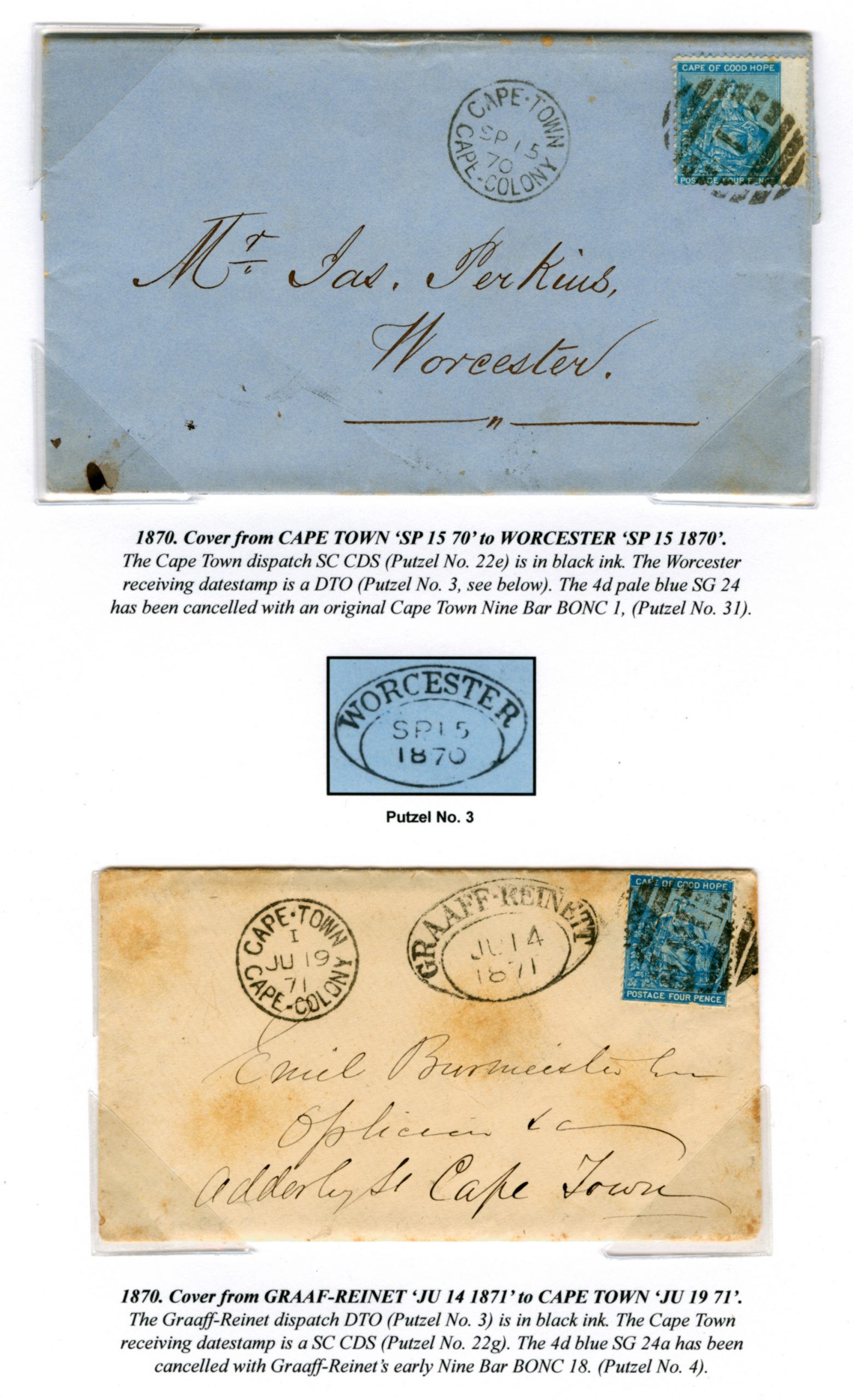
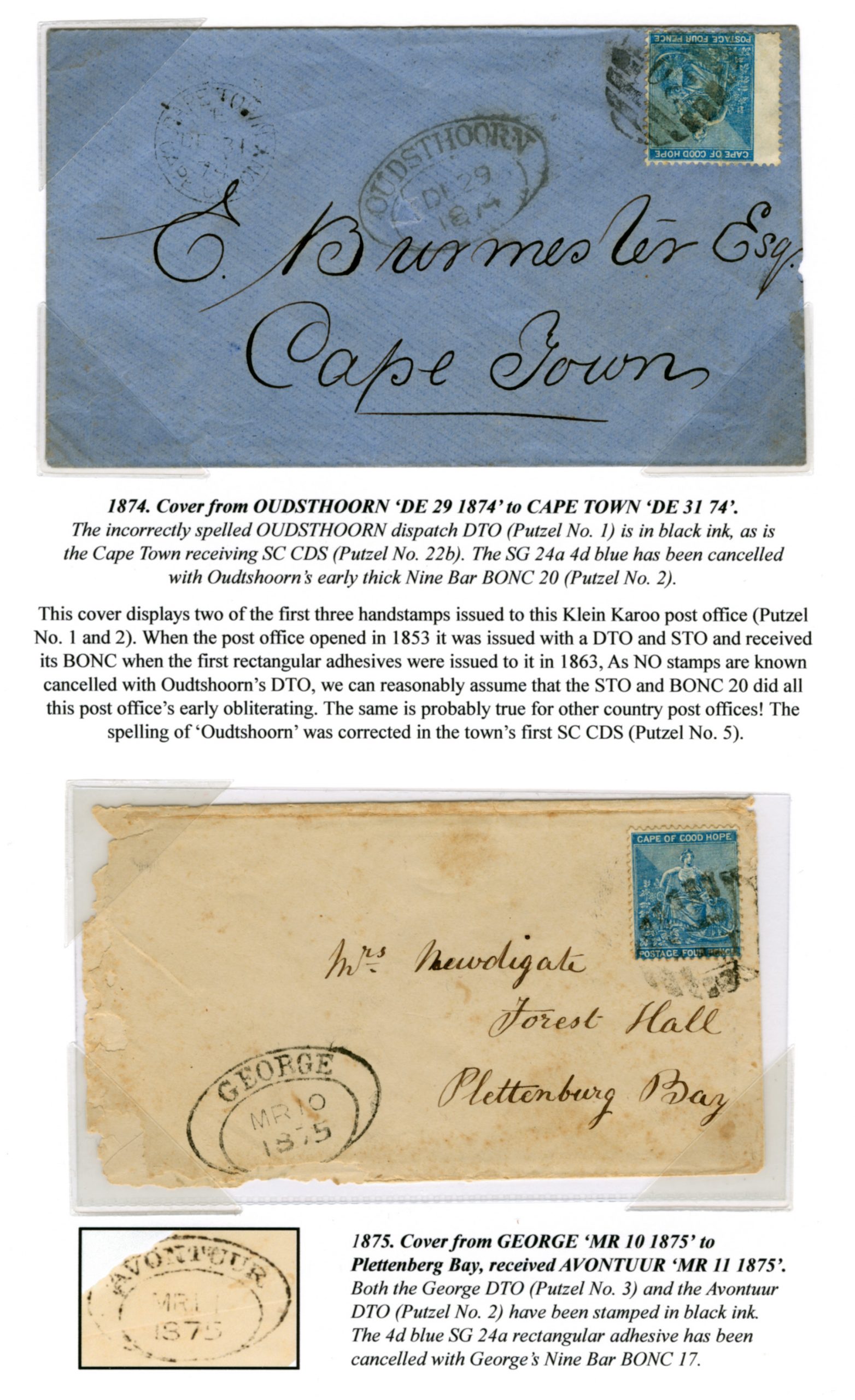
The Uncollectable BONC
In the 1930s in South Africa few people collected postmarks. Among those who did, BONCs came last. Almost no-one valued them. It was possible to pick them up for next to nothing. Over time that changed. To see how far the recording of BONCs has come, see Mordant's 'Barred Oval Numeral Cancellers of the Cape of Good Hope 1863-1963' on this site. You can save this as a PDF and print it out and use it as a reference if need be. If you have proving pieces for some of David's 'gaps', please send him a scan of your example. It is by getting involved and sharing information that our hobby moves forward to a broader understanding of the subject. Thank you.
Maurice Barrette FRPS's wonderful 'London Fancy Geometric Postmarks' is more than just a treatise on the 'Squared Circle Datestamp', it is also a very entertaining read. Here is an extract from the Forward. "Like species studied by paleontologists, handstamps gave birth to lines of descent, by recutting of dies and their evolution can be followed from the original proof to the final design used in the end. As in Paleontology, some "fossils" may still be unrecorded at the origin of some lines, and there may be "missing links" within some other descents..."
Quote from Steve on December 5, 2023, 6:32 pmBelow is a letter describing the experiences of an old-time South African BONC collector. I have taken it from Franco Fescura's wonderful but now sadly defunct 'The Post Office Stone'. (If you have copies of this publication for sale, please let me know. I will buy them)
An early BONC Collector
Mr F. G. Froehlich was, presumably a German Jewish refuge who came to South Africa in 1936, the same year as Ralph Putzel RDPSA who arrived on his 16th birthday. His humorous letter contains a useful historic perspective on BONCs as well as the wisdom of a lifetime. His suggests that interest in BONCs developed after Jurgens'book. His "most fundamental law in all Philately" should be taken seriously by all collectors. It is as true today as it was then. If this law is ignored his comment that the consequences will be "too ghastly to contemplate" is a popular contemporary catchphrase taken, I believe, from a speech made by SA Prime Minister John Vorster in 1974 about the possibility of the Rhodesian Lusaka Agreement not succeeding. It shows South African politics clouding philately.
A BONC Research Timeline
Our knowledge of BONCS comes from the work of postal historians who preceded us. Mr Froelich's letter to Franco Frescura, then Editor of THE POST OFFICE STONE, 'the official' Quarterly Journal of the Postmark and Postal History Society of Southern Africa, Johannesburg, (1981 to 1984), is a timely reminder that helps us get the advance of BONC study and knowledge in perspective.
- 1930: Gilbert Allis' (Cape of Good Hope - Its Postal History & Postage Stamps'.) A philatelic start to Cape postal history.
- 1936: Mr Froelich arrives in SA. He collects BONCs which dealers neglect until Jurgens' book adds new interest in them.
- 1943: A. A. Jurgens (Handstruck Letter Stamps of the Cape of Good Hope & Postmarks 1792 to 1910'.). A cat among pigeons.
- 1984: Robert Goldblatt (Postmarks of the Cape of Good Hope.) A popular reference that draws heavily on Jurgens' flawed work.
- 1981 - 1984: Frescura edits The Post Office Stone, the first academic documentation of Cape postmarks and their ER/LRs.
- 1994: Ralph Putzel (The Postmarks of South Africa and Forner States and Colonies.). Ambitious, lacking, incomplete, magnificent.
- 2020: David Mordant (Barred Oval Numeral Cancellers of the Cape of Good Hope 1863-1963.). A BONC-specific leap forward.
- 2021: Franco Frescura & Alex Visser. (Revised Listing of POs & Postal Markings of the CoGH 1792 -1910.). A really useful general study.
- 2023: A Visser (Online Addendum to Putzel). An ongoing source of SA postmark discoveries and documentation.
NOTE: As an indicator to changing times and increased knowledge, the first six publications are printed media ie. books. Generally, you cannot access this data without buying a book (whose advice dates with every new discovery). However, from 2020 all the latest publications with updated information are available as a FREE PDF download on-line. My advice is that you keep what books you have for their historic perspectives but in addition you must acquire both Mordant's 2020 and Frescura / Visser's 2021 work and cross-reference these in your work setting out your BONC display. There are differences between them. Also, and usefully, Frecura / Visser's work contains added information on the various datestamps used with BONCs. Not only are these datestamps another fascinating field of study but they represent to some extent another way to identify the earlier BONCs of 1864/65 from those that came later.
Evolution and origin of the CoGH BONC
I briefly return here to the evolution and origin of the CoGH BONC with the first image below. I thought I could make this clearer. As you can see it shows the early horizontal BN (Barred Numeral) Canceller morphing into the BN Duplex canceller 'DE 21 1860'. This BN would soon evolve into something closely resembling a Cape BONC.
The Noble but Unattractive BONC
In the previous post, I wrote that "By themselves BONCs are not particularly attractive.". I now come back to that statement. Making a display attractive and interesting must be the aim of anyone interested in any subject.
We started with a little History of how the BONC developed in GB and what their purpose was there and in the Cape. You could embellish that with some coverage of the process whereby the Cape Post Office made the decision to acquire them. Personally I am not a big fan of ancient committee meeting notes, especially when we are trying to make BONCs look an interesting and lively subject. The sheet below does not succeed in that regard. To all intents its a 'basinful of BONCs', dull and aimless, nowhere to go but BONC soup.
This boring page of BONCs with few early examples is not much to look at. What does it do for our understanding of the subject? Not a lot. These might be of limited use as research items and individual examples but there is little to be learned from them presented like this. Imagine how much better these stamps would have looked on their original covers had philatelic vandals not plundered them!
Relying too heavily on Goldblatt who relied on Jurgens
Below is part of a sheet I wrote up many years ago for a study of the fourteen (or so) recorded handstamps used to cancel Cape Triangulars. It has been displayed once and has lain in abeyance since then awaiting a re-write. Looking at them now, they seem a reasonably attractive first effort but there is much that is WRONG with it. Why? Because I used Goldblatt without referencing others also. If you are displaying BONCs, don't perpetuate old errors and misinformation by taking Goldblatt at face value like I did. Get a copy of Mordant or Frescura for FREE! Your display will be much more accurate and up-to-date if you do.
The image below shows six BONCs from Goldblatt's book. They may be Thick Nine Bar BONCs but are they all from the 1864/65 issue. Similarly the examples on piece. The Paarl BONC 39 has a low numeral below 50 which can easily be assumed to make it one of the first Thick Nine Bar BONCs of 1864/65 to be issued. However, its flat-headed '3' shows it to be one of those issued in 1882/83. Ditto Willowmore's BONC 66 is only recorded much later in 1896. BONC 216 is recorded used in French Hoek 1893 and Blaney Junction in 1898. The Lesson here is that a low Number on a Thick Nine Bar BONC is not always an early issue. I made this mistake. A lot!
The CoGH BONC was released some 10 years after the Triangular stamp was introduced in 1853. Its purpose was to replace and or work alongside the Triangular Obliterator which according to my study of some 3,500 Triangles had cancelled 79.2% of all Cape Triangles. In any event, the Triangular Obliterator continued to have an active life in many Cape post offices for many years after the introduction of the BONC.
The BONC was intended to become the main means of obliterating the new rectangular definitives of 1863/64. By the time time that BONCs were issued between 1864 - 1865, stocks of Cape Triangular adhesives had already run low and as a result those cancelled by BONCs are far fewer in number when compared to hundred of thousands cancelled by the Triangular Obliterator. So, any page(s) showing BONCs cancelling triangles can be promoted as a relatively scarce treat within a display. However, the cost of finding a BONC cancelling a Triangular stamp on cover is probably prohibitive for many Cape collectors, certainly this one!
The display sheet below shows BONCs obliterating the first Rectangular issue. I use this to show that collectively BONCs on stamps when presented en masse can appear dull and desperately in need of some jazzing up. By themselves BONCs are not particularly attractive. They all look much the same except for the numbers. Of course, there are variations in the number of horizontal bars and the size of the rectangle holding the numeral but generally, they are pretty similar.
Often, it is the colourful stamps they are on that stand out most despite the BONC's best efforts to obliterate them, that being its primary purpose in postal life along with identifying the town of dispatch by its numeral. Nevertheless, they are not easy to display. So, how do we make the subject of BONCs appear 'interesting'? It should be easy! It is a fascinating collecting field, one full of misinformation.
Perhaps a better way to display them is by value and stamp issue - if you have enough to fill all the rows. None of this looks very exciting. Eye candy it is not! This highlights the background of your BONC display, indeed any display. What shows up your examples best, Black or White? It is pretty much six of one and half-a-dozen of the other but I will always prefer Black because it has the effect of saturating the colours it surrounds more than White does ie. a Black background will make your stamp stand out more.
The final sheet are for those who are interested in my research into the Postmarks found cancelling the Cape Classics. This comes from a display that attempts to identify forged Cape Triangles by their faked postmarks. Among the some 3500 Triangles I studied, BONCs were found cancelling only 6% of Cape Triangles. This placed them second as a defined canceller but third as a category.
The Great Shaggy Beast of Cape Triangle obliteration was the Triangular Obliterator. This was found cancelling 79.2% of all examples studied. Next and somewhat surprisingly second, was Unidentifiable Smudges at 7.4% with BONCs narrowly behind on 6%. My sample size was rather small and my figures now appear wrong. Also, I can now no longer offer a reason why the 1868 Three Pence overprint on a Rectangle was included other than at the time I regarded it as a Classic stamp. (It was not included in my Triangle study.)
Of interest perhaps is the Enlarged View of the 1/- green Rectangle. Given the size of a stamp or postmark being studied, enlargement is a perfectly legitimate and useful form of illustration in any display, especially one based on computer technology. However, judges in formal society display may frown on this. Unless you are entering one of their competitions and you fear you will be marked down for such a breach, there is no good reason in a general display not to make details more obvious by enlargement. It is a useful option to have up your sleeve.
Below is a letter describing the experiences of an old-time South African BONC collector. I have taken it from Franco Fescura's wonderful but now sadly defunct 'The Post Office Stone'. (If you have copies of this publication for sale, please let me know. I will buy them)
An early BONC Collector
Mr F. G. Froehlich was, presumably a German Jewish refuge who came to South Africa in 1936, the same year as Ralph Putzel RDPSA who arrived on his 16th birthday. His humorous letter contains a useful historic perspective on BONCs as well as the wisdom of a lifetime. His suggests that interest in BONCs developed after Jurgens'book. His "most fundamental law in all Philately" should be taken seriously by all collectors. It is as true today as it was then. If this law is ignored his comment that the consequences will be "too ghastly to contemplate" is a popular contemporary catchphrase taken, I believe, from a speech made by SA Prime Minister John Vorster in 1974 about the possibility of the Rhodesian Lusaka Agreement not succeeding. It shows South African politics clouding philately.
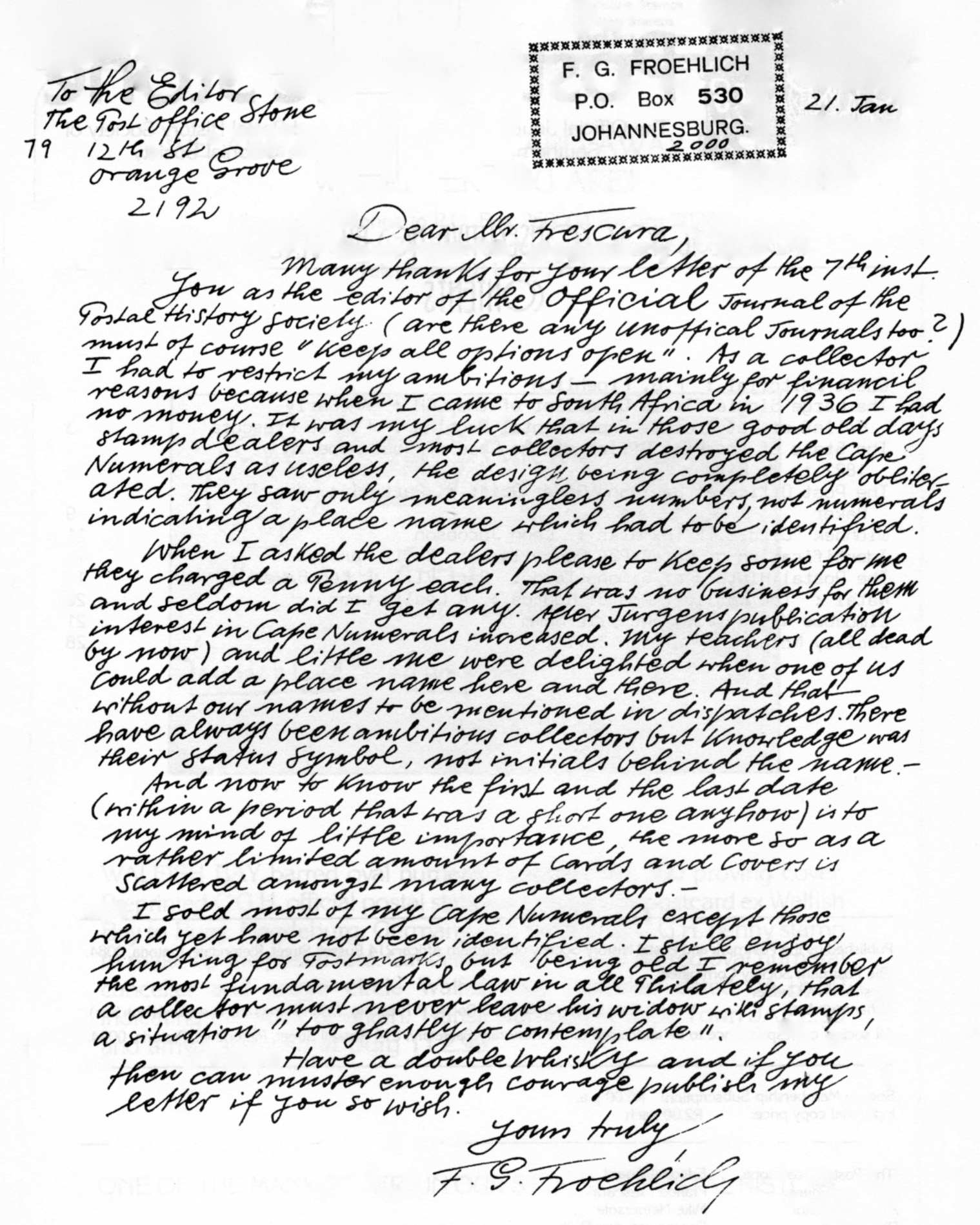 A BONC Research Timeline
A BONC Research Timeline
Our knowledge of BONCS comes from the work of postal historians who preceded us. Mr Froelich's letter to Franco Frescura, then Editor of THE POST OFFICE STONE, 'the official' Quarterly Journal of the Postmark and Postal History Society of Southern Africa, Johannesburg, (1981 to 1984), is a timely reminder that helps us get the advance of BONC study and knowledge in perspective.
- 1930: Gilbert Allis' (Cape of Good Hope - Its Postal History & Postage Stamps'.) A philatelic start to Cape postal history.
- 1936: Mr Froelich arrives in SA. He collects BONCs which dealers neglect until Jurgens' book adds new interest in them.
- 1943: A. A. Jurgens (Handstruck Letter Stamps of the Cape of Good Hope & Postmarks 1792 to 1910'.). A cat among pigeons.
- 1984: Robert Goldblatt (Postmarks of the Cape of Good Hope.) A popular reference that draws heavily on Jurgens' flawed work.
- 1981 - 1984: Frescura edits The Post Office Stone, the first academic documentation of Cape postmarks and their ER/LRs.
- 1994: Ralph Putzel (The Postmarks of South Africa and Forner States and Colonies.). Ambitious, lacking, incomplete, magnificent.
- 2020: David Mordant (Barred Oval Numeral Cancellers of the Cape of Good Hope 1863-1963.). A BONC-specific leap forward.
- 2021: Franco Frescura & Alex Visser. (Revised Listing of POs & Postal Markings of the CoGH 1792 -1910.). A really useful general study.
- 2023: A Visser (Online Addendum to Putzel). An ongoing source of SA postmark discoveries and documentation.
NOTE: As an indicator to changing times and increased knowledge, the first six publications are printed media ie. books. Generally, you cannot access this data without buying a book (whose advice dates with every new discovery). However, from 2020 all the latest publications with updated information are available as a FREE PDF download on-line. My advice is that you keep what books you have for their historic perspectives but in addition you must acquire both Mordant's 2020 and Frescura / Visser's 2021 work and cross-reference these in your work setting out your BONC display. There are differences between them. Also, and usefully, Frecura / Visser's work contains added information on the various datestamps used with BONCs. Not only are these datestamps another fascinating field of study but they represent to some extent another way to identify the earlier BONCs of 1864/65 from those that came later.
Evolution and origin of the CoGH BONC
I briefly return here to the evolution and origin of the CoGH BONC with the first image below. I thought I could make this clearer. As you can see it shows the early horizontal BN (Barred Numeral) Canceller morphing into the BN Duplex canceller 'DE 21 1860'. This BN would soon evolve into something closely resembling a Cape BONC.
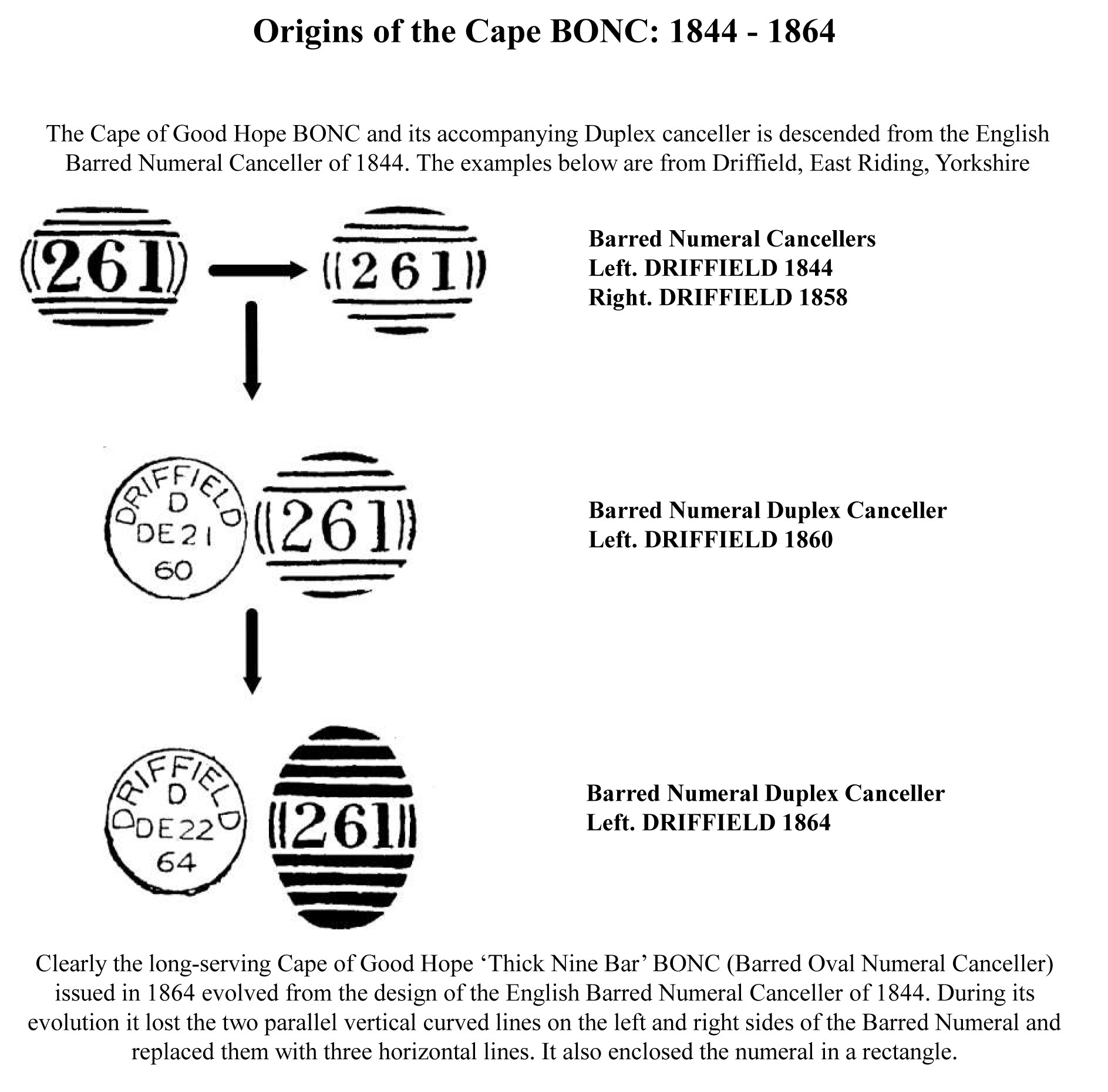 The Noble but Unattractive BONC
The Noble but Unattractive BONC
In the previous post, I wrote that "By themselves BONCs are not particularly attractive.". I now come back to that statement. Making a display attractive and interesting must be the aim of anyone interested in any subject.
We started with a little History of how the BONC developed in GB and what their purpose was there and in the Cape. You could embellish that with some coverage of the process whereby the Cape Post Office made the decision to acquire them. Personally I am not a big fan of ancient committee meeting notes, especially when we are trying to make BONCs look an interesting and lively subject. The sheet below does not succeed in that regard. To all intents its a 'basinful of BONCs', dull and aimless, nowhere to go but BONC soup.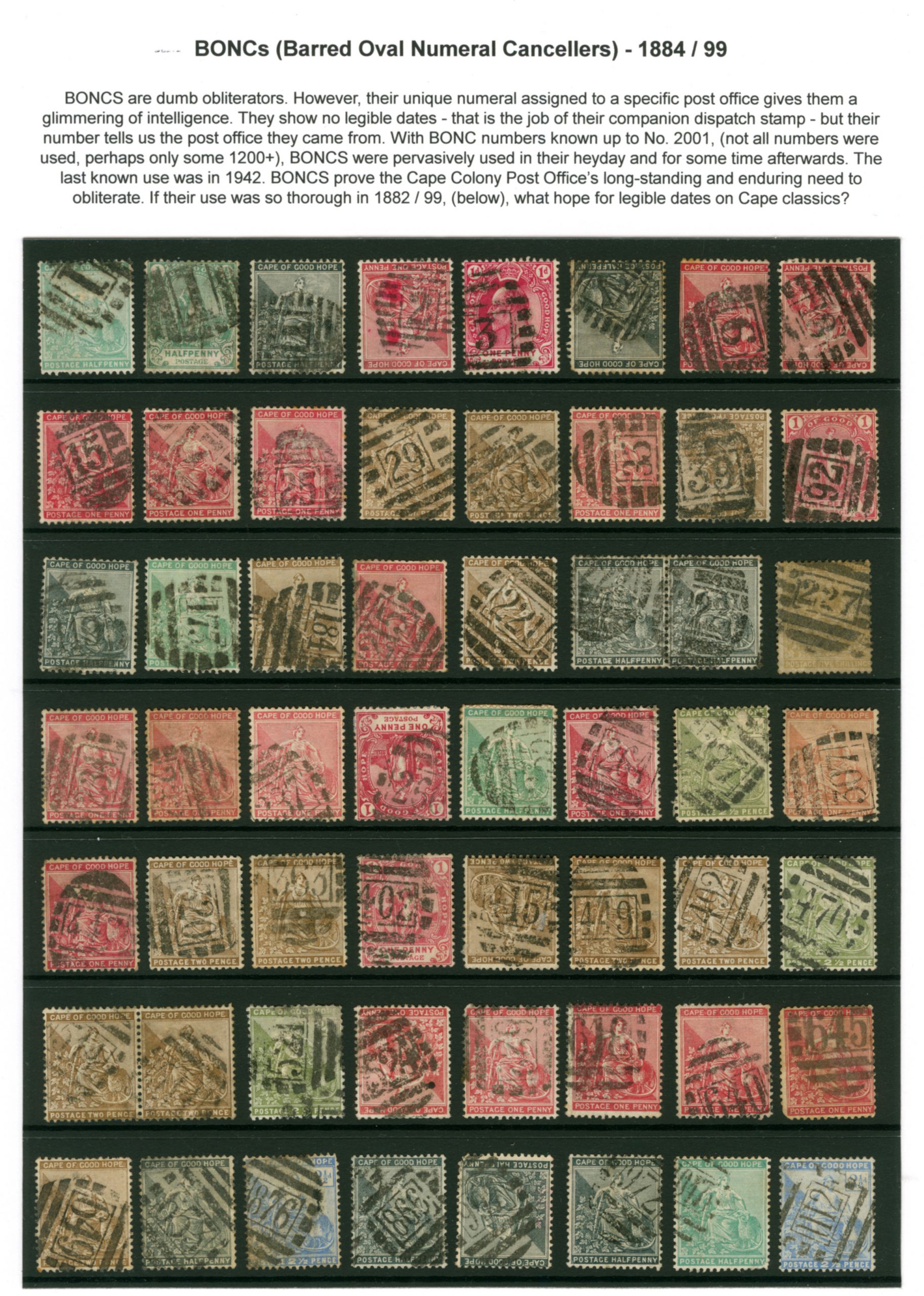
This boring page of BONCs with few early examples is not much to look at. What does it do for our understanding of the subject? Not a lot. These might be of limited use as research items and individual examples but there is little to be learned from them presented like this. Imagine how much better these stamps would have looked on their original covers had philatelic vandals not plundered them!
Relying too heavily on Goldblatt who relied on Jurgens
Below is part of a sheet I wrote up many years ago for a study of the fourteen (or so) recorded handstamps used to cancel Cape Triangulars. It has been displayed once and has lain in abeyance since then awaiting a re-write. Looking at them now, they seem a reasonably attractive first effort but there is much that is WRONG with it. Why? Because I used Goldblatt without referencing others also. If you are displaying BONCs, don't perpetuate old errors and misinformation by taking Goldblatt at face value like I did. Get a copy of Mordant or Frescura for FREE! Your display will be much more accurate and up-to-date if you do.
The image below shows six BONCs from Goldblatt's book. They may be Thick Nine Bar BONCs but are they all from the 1864/65 issue. Similarly the examples on piece. The Paarl BONC 39 has a low numeral below 50 which can easily be assumed to make it one of the first Thick Nine Bar BONCs of 1864/65 to be issued. However, its flat-headed '3' shows it to be one of those issued in 1882/83. Ditto Willowmore's BONC 66 is only recorded much later in 1896. BONC 216 is recorded used in French Hoek 1893 and Blaney Junction in 1898. The Lesson here is that a low Number on a Thick Nine Bar BONC is not always an early issue. I made this mistake. A lot!
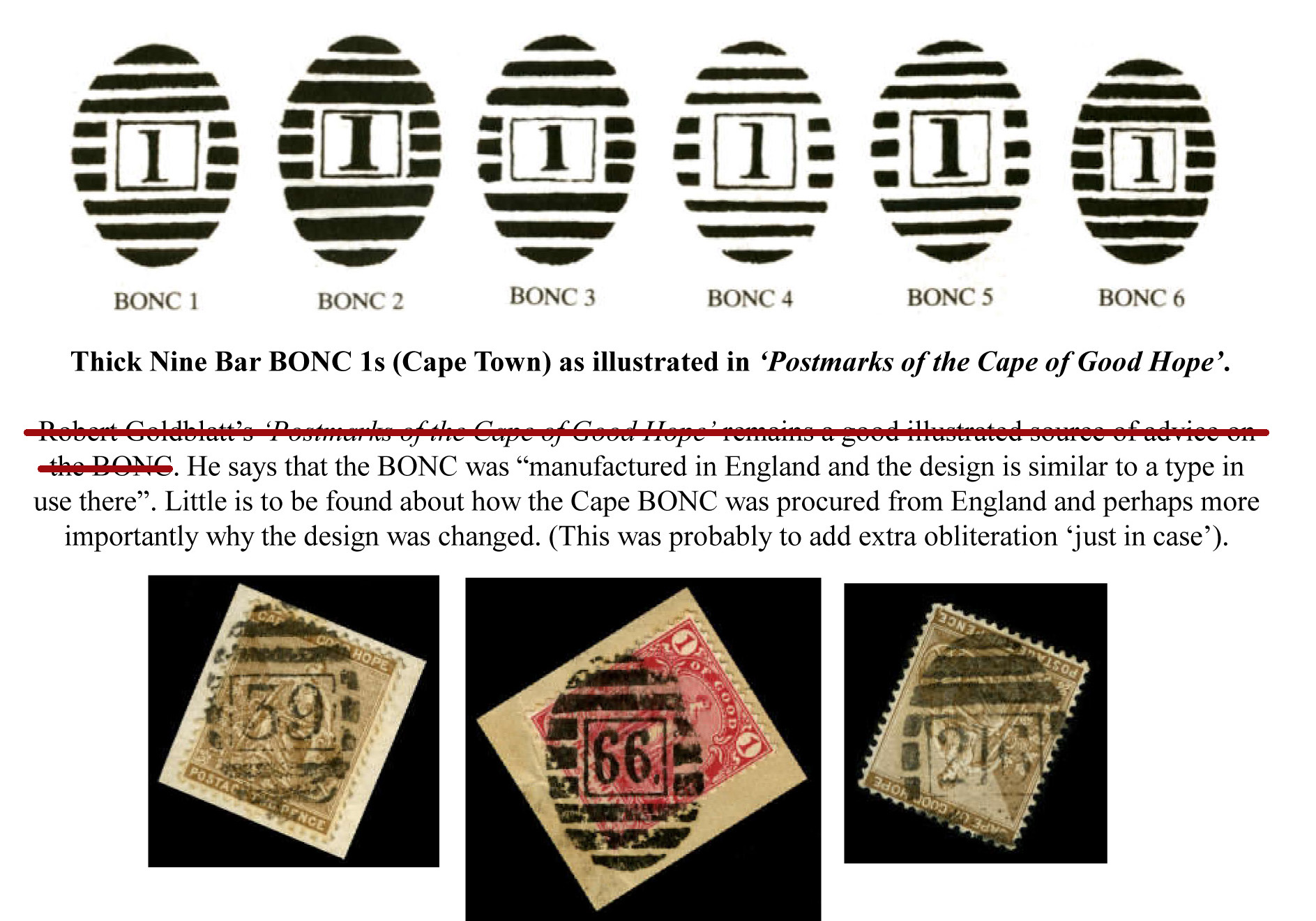
The CoGH BONC was released some 10 years after the Triangular stamp was introduced in 1853. Its purpose was to replace and or work alongside the Triangular Obliterator which according to my study of some 3,500 Triangles had cancelled 79.2% of all Cape Triangles. In any event, the Triangular Obliterator continued to have an active life in many Cape post offices for many years after the introduction of the BONC.
The BONC was intended to become the main means of obliterating the new rectangular definitives of 1863/64. By the time time that BONCs were issued between 1864 - 1865, stocks of Cape Triangular adhesives had already run low and as a result those cancelled by BONCs are far fewer in number when compared to hundred of thousands cancelled by the Triangular Obliterator. So, any page(s) showing BONCs cancelling triangles can be promoted as a relatively scarce treat within a display. However, the cost of finding a BONC cancelling a Triangular stamp on cover is probably prohibitive for many Cape collectors, certainly this one!
The display sheet below shows BONCs obliterating the first Rectangular issue. I use this to show that collectively BONCs on stamps when presented en masse can appear dull and desperately in need of some jazzing up. By themselves BONCs are not particularly attractive. They all look much the same except for the numbers. Of course, there are variations in the number of horizontal bars and the size of the rectangle holding the numeral but generally, they are pretty similar.
Often, it is the colourful stamps they are on that stand out most despite the BONC's best efforts to obliterate them, that being its primary purpose in postal life along with identifying the town of dispatch by its numeral. Nevertheless, they are not easy to display. So, how do we make the subject of BONCs appear 'interesting'? It should be easy! It is a fascinating collecting field, one full of misinformation.
Perhaps a better way to display them is by value and stamp issue - if you have enough to fill all the rows. None of this looks very exciting. Eye candy it is not! This highlights the background of your BONC display, indeed any display. What shows up your examples best, Black or White? It is pretty much six of one and half-a-dozen of the other but I will always prefer Black because it has the effect of saturating the colours it surrounds more than White does ie. a Black background will make your stamp stand out more.
The final sheet are for those who are interested in my research into the Postmarks found cancelling the Cape Classics. This comes from a display that attempts to identify forged Cape Triangles by their faked postmarks. Among the some 3500 Triangles I studied, BONCs were found cancelling only 6% of Cape Triangles. This placed them second as a defined canceller but third as a category.
The Great Shaggy Beast of Cape Triangle obliteration was the Triangular Obliterator. This was found cancelling 79.2% of all examples studied. Next and somewhat surprisingly second, was Unidentifiable Smudges at 7.4% with BONCs narrowly behind on 6%. My sample size was rather small and my figures now appear wrong. Also, I can now no longer offer a reason why the 1868 Three Pence overprint on a Rectangle was included other than at the time I regarded it as a Classic stamp. (It was not included in my Triangle study.)
Of interest perhaps is the Enlarged View of the 1/- green Rectangle. Given the size of a stamp or postmark being studied, enlargement is a perfectly legitimate and useful form of illustration in any display, especially one based on computer technology. However, judges in formal society display may frown on this. Unless you are entering one of their competitions and you fear you will be marked down for such a breach, there is no good reason in a general display not to make details more obvious by enlargement. It is a useful option to have up your sleeve.
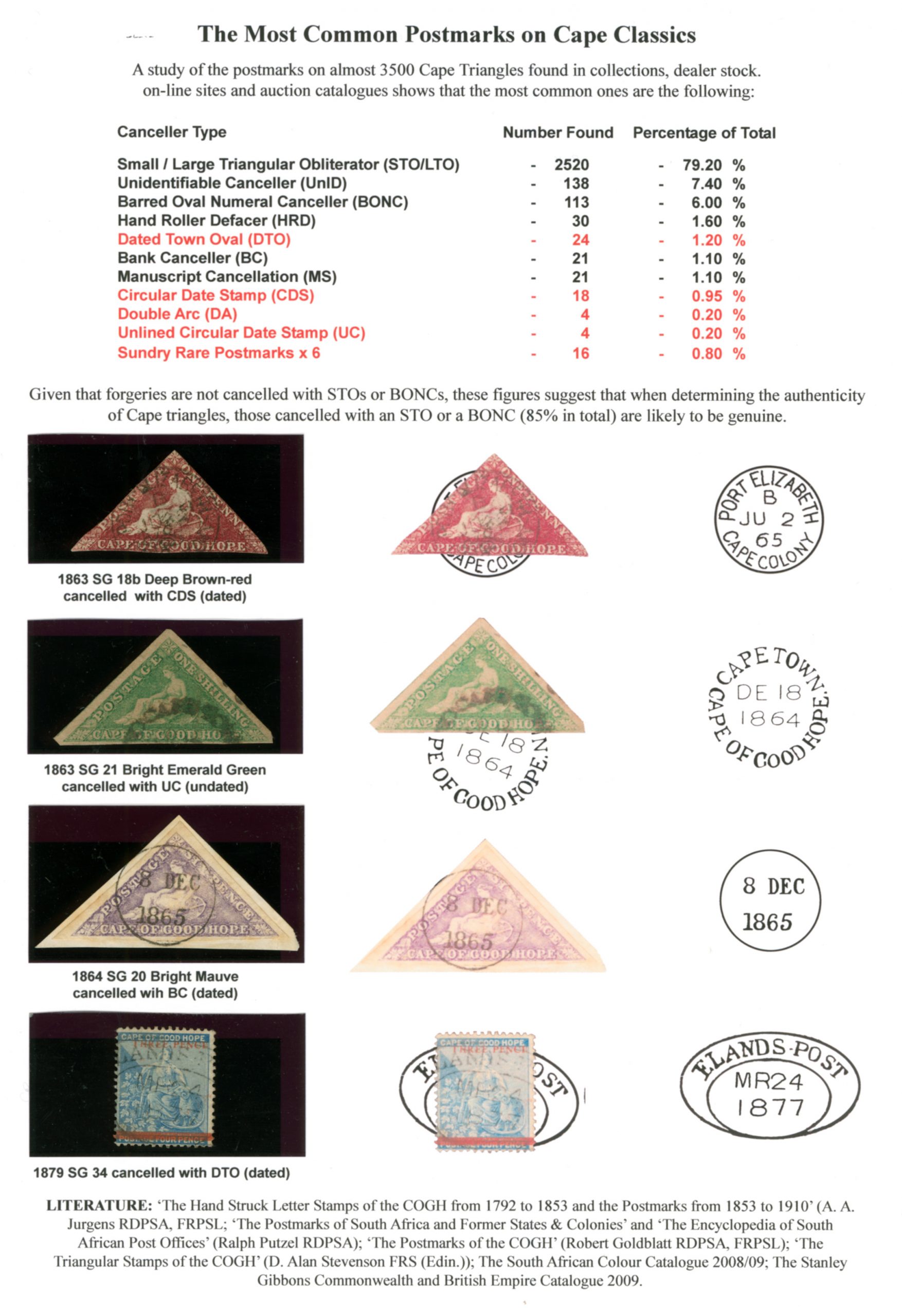
Quote from Steve on December 6, 2023, 2:07 pmHow to Display BONCs - By Number or Alphabetically by town?.
If you decide to display Cape BONCs alphabeticaly you will, according to Goldblatt, start with:
- Abercorn, Nyasaland - BONC 860 and 871
- Aberdeen - BONC 20
- Aberfeldy Rail Office - BONC 75
- Achter Sneeuwberg - BONC 586
- Addo - BONC 128, etc, etc.
Why would you want to do this? Imperfect as displaying BONCs in Numeral order is, it makes more immediate sense.
If you decide to display Cape BONCs numerically you will, according to Goldblatt, start with:
- BONC 1 - Cape Town
- BONC 2 - Port Elizabeth
- BONC 3 - Grahamstown,
- BONC 4 - King Williamstown,
- BONC 5 - Avontuur, etc, etc.
Goldblatt's Thumb-Suckingly Good Pie-in-the Sky
After the Second British Occupation of the Cape in 1806 there was huge growth in rural European settlement, much of it in the Eastern Cape as a buffer to the aggrieved and dispossessed Xhosa tribe. According to Goldblatt, "by 1865 about 500 post offices and postal agencies in the Cape had been issued with the 'Thick Bar' Numeral Canceller of 1864". This statement implies that at least 500 BONCs (presumably numbered 1 - 500) had been issued across the Cape by 1865. Today, Mordant says that in 1864/65 the number pf BONCs issued was 39 and by 1874 it was 161. How Goldblatt came by his pie-in-the sky thumbsuck of 500 is a mystery but postal history is the poorer!
Between 1817 - 1824 the British had issued 19 CiC (Crown-in-Circle) town handstamps to post offices outside Cape Town. As a result of Goldblatt's misinformation - and my lack of independent research - I wrote "The need to supply "500 post offices and postal agencies" with BONC handstamps reflects the growth of rural settlement supported by postal services that had occurred in the 40 years since the first CiC town handstamps were issued. The "about 500" post offices that received the Thick Nine Bar BONC numeral formed the bedrock on which the mid-19th Century Cape postal system that preceded the discovery of diamonds (1866-67) and the building of the railways to exploit this bonanza was built." Boy, was I wrong! In my defence, I did have a sense of unease and was slowly questioning things based on my belief something was wrong. Where were these 500 BONCs from 1864/65. Answer: They did not exist until later!
One of my first questions before I discovered the answer in Mordant'sd work was "How many BONC handstamps did the Cape Post Office receive when it first took delivery of them?". Not wanting to make assumptions and or guess, I began to list the historic main Cape towns in the hope that I would see a pattern of BONC distribution emerge upon which I could build a broader picture of the introduction and ongoing use of the BONC. In doing so, I began to have serious doubts about Goldblatt's claim of 500.
There were few towns in the Dutch Cape, 1652 - 1795. Started as a VOC trading post and replenishment station in 1652, Cape Town has always been the Cape's pre-eminent town and city. Stellenbosch was the first to be founded outside Cape Town in 1679. It was followed by the farming communities of Paarl in roughly 1688 and Tulbagh ('Land van Waveren') in 1699. In 1743 Swellendam, a two-house VOC frontier administrative centre in the Western Cape, and Simons Town, a naval anchorage, were founded. Lastly, to catch up with the trekkers, the VOC founded Graaff-Reinet as a one-horse Eastern Cape VOC frontier administrative centre in 1786.
Looking at these early Dutch / VOC towns and settlents, we see:
- Cape Town 1652 BONC 1
- Stellenbosch 1679 BONC 13, 1047
- Paarl 1688 BONC 39, 751
- Tulbagh 1699 BONC 816
- Swellendam 1743 BONC 12
- Simons Town 1743 BONC 27, 1047
- Graaff-Reinet 1786 BONC 18, 201, 230, 612
As you can see from the above, except in the case of Cape Town, the date of a town's founding and its early historical importance did not greatly influence the allocation of a low BONC numeral in 1864/65. As the seven towns above had been included among the 19 towns that received a CiC town handstamp, the first to be issued to country town post offices outside Cape Town, I thought to include the other 12 of the 19 towns deemed important enough to receive a CiC handstamp in my list of possible early issue BONCs.
Adding post offices that received CiC handstamps (not shown above):
- Uitenhage 1804 BONC 14, 416
- Caledon 1810 BONC 250, 255, 485
- George 1811 BONC 17, 21, 34
- Somerset (East) 1823 BONC 21, 556
- Cradock 1813 BONC 22, 41, 79, 226, 945, 1011
- Worcester 1820 BONC 15
- Port Elizabeth 1799 BONC 2
- Clanwilliam 1814 BONC 10
- Grahamstown 1812 BONC 3, 167, 230
- Beaufort (West) 1818 BONC 22, 202, 463, 588, 702, 866
- Bathurst 1820 BONC ...
- Kowie (various, today Port Alfred) 1824 BONC ...
A few conclusions and some more questions
1]. There are gaps in our knowledge. Goldblatt's Alphabetical listing of towns receiving a BONC does not include either Bathurst or Kowie. This implies these towns did not receive one. However, in his Numerical listing of Post Offices Goldblatt tells us that Bathurst used BONC 684. Clearly, in respect of Bathurst, Goldblatt's Alphabetic list does not cross-match with his Numeric one.
Writing some 20 years later, Putzel tells us that Bathurst used BONC 310 and 684. (Frescura / Visser and Mordant concur). This is an example of new discoveries expanding on what was previously unrecorded and unknown to Goldblatt. He lists BONC 310 at 'Jan Fouries Kraal', as do Frescura / Visser on '15 DE 1883'.) Some 405 BONCs known used, mostly with high numbers, remain to be identified.
2]. We need more up-to-date expert advice. Fortunately that is downloadable in the form of Mordant's and Frescura / Visser's work. Regarding Bathurst, the latter say that two Nine Bar BONCs, 310 (ER 19 FE 96 - LR 13 NO 1897) and 684 (NO ER or LR), were used there. BONC 684's lack of substantiating ER and LR must make its use suspect. Regarding Kowie. (after many name changes it is today's Port Alfred), it appears to have never received a BONC or if it did it remains to be proven. We need to send David Mordant all our new finds, also Frescura / Visser, before they throw in the towel.
3]. Goldblatt referred to "indiscriminate distribution" of the BONC. To me, it appears that the first 100 or so BONCs did go to the more important post offices of the colony. In 1864 there was an attempt to first supply the older post offices and new important ones with a BONC more-or-less as they were received from overseas. It was logical to keep BONC 1 for the Head Office, Cape Town, and to supply the other important post offices with a following low number. Thereafter BONCs were dispatched by necessity.
The lists begins with:
- BONC 1 (Cape Town '8 FE 1863'),
- BONC 2 (Port Elizabeth '3 AU 1864'),
- BONC 3 (Grahamstown '28 JY 1864')
- BONC 4 (King Williamstown '27 SP 1868)), a frontier military base on the Eastern Cape's troubled 'Border'.
- BONC 5 was assigned to Avontuur '12 JA 1865', irrelevant today but back then an important postal hub.
- BONC 6 was allocated to Wynberg, '13 JY 1872', the oldest British Army camp in the Cape. Etc. etc.
We recommend you download Mordant's discerning work and build your display and understanding of the various issues of BONCs around his authority. It's far quicker than making sense of Goldblatt's guff. While it is true there is no logic to the later issuing of BONCs to Cape post offices, the first 39 did receive some consideration for their relative importance. Mordant shows the following distribution.
This is the Good Stuff, the BONC Holy Grail - Thank you, David Mordant!
Below are two proving covers showing relatively late use of what appears to be the 1864 Thick Nine Bar BONC. One is from the Malmesbury post office and the other is from the town's railways station.
Thanks to Mordant's advice rubricated in red above I now know that there were multiple issues of a (3.3.3) BONC and that what appears to be a 1864/65 Thick Nine Bar BONC may be a much later release. We work out that the Malmesbury BONC 215 cannot be the first issue BONC because Frescura / Visser give the ER (Earliest Recorded) for it as '21 JY 1881' with an LR (Last Recorded) of '2 NO 1897' ie. it is not recorded used until 1881, so it is most unlikely to have been issued in 1864/65. Also, it appears to be a new LR of '20 AU 98'.
Malmesbury Station's BONC 235 (3.3.3) has a similar ER / LR of ' 31 MY 1881 to 24 MY 1894'. Given that their recorded use started so late, I questioned how it was that these two devices were held back for so long before being issued. Thanks to David Mordant I now know that there were multiple issues of the Cape BONC and that these ones were probably from the collective issue of 1877. So, just as I am thinking I can sleep easier tonight I am worrying about why they do not have earlier ERs. I would hope it was a rolling issue.
How to Display BONCs - By Number or Alphabetically by town?.
If you decide to display Cape BONCs alphabeticaly you will, according to Goldblatt, start with:
- Abercorn, Nyasaland - BONC 860 and 871
- Aberdeen - BONC 20
- Aberfeldy Rail Office - BONC 75
- Achter Sneeuwberg - BONC 586
- Addo - BONC 128, etc, etc.
Why would you want to do this? Imperfect as displaying BONCs in Numeral order is, it makes more immediate sense.
If you decide to display Cape BONCs numerically you will, according to Goldblatt, start with:
- BONC 1 - Cape Town
- BONC 2 - Port Elizabeth
- BONC 3 - Grahamstown,
- BONC 4 - King Williamstown,
- BONC 5 - Avontuur, etc, etc.
Goldblatt's Thumb-Suckingly Good Pie-in-the Sky
After the Second British Occupation of the Cape in 1806 there was huge growth in rural European settlement, much of it in the Eastern Cape as a buffer to the aggrieved and dispossessed Xhosa tribe. According to Goldblatt, "by 1865 about 500 post offices and postal agencies in the Cape had been issued with the 'Thick Bar' Numeral Canceller of 1864". This statement implies that at least 500 BONCs (presumably numbered 1 - 500) had been issued across the Cape by 1865. Today, Mordant says that in 1864/65 the number pf BONCs issued was 39 and by 1874 it was 161. How Goldblatt came by his pie-in-the sky thumbsuck of 500 is a mystery but postal history is the poorer!
Between 1817 - 1824 the British had issued 19 CiC (Crown-in-Circle) town handstamps to post offices outside Cape Town. As a result of Goldblatt's misinformation - and my lack of independent research - I wrote "The need to supply "500 post offices and postal agencies" with BONC handstamps reflects the growth of rural settlement supported by postal services that had occurred in the 40 years since the first CiC town handstamps were issued. The "about 500" post offices that received the Thick Nine Bar BONC numeral formed the bedrock on which the mid-19th Century Cape postal system that preceded the discovery of diamonds (1866-67) and the building of the railways to exploit this bonanza was built." Boy, was I wrong! In my defence, I did have a sense of unease and was slowly questioning things based on my belief something was wrong. Where were these 500 BONCs from 1864/65. Answer: They did not exist until later!
One of my first questions before I discovered the answer in Mordant'sd work was "How many BONC handstamps did the Cape Post Office receive when it first took delivery of them?". Not wanting to make assumptions and or guess, I began to list the historic main Cape towns in the hope that I would see a pattern of BONC distribution emerge upon which I could build a broader picture of the introduction and ongoing use of the BONC. In doing so, I began to have serious doubts about Goldblatt's claim of 500.
There were few towns in the Dutch Cape, 1652 - 1795. Started as a VOC trading post and replenishment station in 1652, Cape Town has always been the Cape's pre-eminent town and city. Stellenbosch was the first to be founded outside Cape Town in 1679. It was followed by the farming communities of Paarl in roughly 1688 and Tulbagh ('Land van Waveren') in 1699. In 1743 Swellendam, a two-house VOC frontier administrative centre in the Western Cape, and Simons Town, a naval anchorage, were founded. Lastly, to catch up with the trekkers, the VOC founded Graaff-Reinet as a one-horse Eastern Cape VOC frontier administrative centre in 1786.
Looking at these early Dutch / VOC towns and settlents, we see:
- Cape Town 1652 BONC 1
- Stellenbosch 1679 BONC 13, 1047
- Paarl 1688 BONC 39, 751
- Tulbagh 1699 BONC 816
- Swellendam 1743 BONC 12
- Simons Town 1743 BONC 27, 1047
- Graaff-Reinet 1786 BONC 18, 201, 230, 612
As you can see from the above, except in the case of Cape Town, the date of a town's founding and its early historical importance did not greatly influence the allocation of a low BONC numeral in 1864/65. As the seven towns above had been included among the 19 towns that received a CiC town handstamp, the first to be issued to country town post offices outside Cape Town, I thought to include the other 12 of the 19 towns deemed important enough to receive a CiC handstamp in my list of possible early issue BONCs.
Adding post offices that received CiC handstamps (not shown above):
- Uitenhage 1804 BONC 14, 416
- Caledon 1810 BONC 250, 255, 485
- George 1811 BONC 17, 21, 34
- Somerset (East) 1823 BONC 21, 556
- Cradock 1813 BONC 22, 41, 79, 226, 945, 1011
- Worcester 1820 BONC 15
- Port Elizabeth 1799 BONC 2
- Clanwilliam 1814 BONC 10
- Grahamstown 1812 BONC 3, 167, 230
- Beaufort (West) 1818 BONC 22, 202, 463, 588, 702, 866
- Bathurst 1820 BONC ...
- Kowie (various, today Port Alfred) 1824 BONC ...
A few conclusions and some more questions
1]. There are gaps in our knowledge. Goldblatt's Alphabetical listing of towns receiving a BONC does not include either Bathurst or Kowie. This implies these towns did not receive one. However, in his Numerical listing of Post Offices Goldblatt tells us that Bathurst used BONC 684. Clearly, in respect of Bathurst, Goldblatt's Alphabetic list does not cross-match with his Numeric one.
Writing some 20 years later, Putzel tells us that Bathurst used BONC 310 and 684. (Frescura / Visser and Mordant concur). This is an example of new discoveries expanding on what was previously unrecorded and unknown to Goldblatt. He lists BONC 310 at 'Jan Fouries Kraal', as do Frescura / Visser on '15 DE 1883'.) Some 405 BONCs known used, mostly with high numbers, remain to be identified.
2]. We need more up-to-date expert advice. Fortunately that is downloadable in the form of Mordant's and Frescura / Visser's work. Regarding Bathurst, the latter say that two Nine Bar BONCs, 310 (ER 19 FE 96 - LR 13 NO 1897) and 684 (NO ER or LR), were used there. BONC 684's lack of substantiating ER and LR must make its use suspect. Regarding Kowie. (after many name changes it is today's Port Alfred), it appears to have never received a BONC or if it did it remains to be proven. We need to send David Mordant all our new finds, also Frescura / Visser, before they throw in the towel.
3]. Goldblatt referred to "indiscriminate distribution" of the BONC. To me, it appears that the first 100 or so BONCs did go to the more important post offices of the colony. In 1864 there was an attempt to first supply the older post offices and new important ones with a BONC more-or-less as they were received from overseas. It was logical to keep BONC 1 for the Head Office, Cape Town, and to supply the other important post offices with a following low number. Thereafter BONCs were dispatched by necessity.
The lists begins with:
- BONC 1 (Cape Town '8 FE 1863'),
- BONC 2 (Port Elizabeth '3 AU 1864'),
- BONC 3 (Grahamstown '28 JY 1864')
- BONC 4 (King Williamstown '27 SP 1868)), a frontier military base on the Eastern Cape's troubled 'Border'.
- BONC 5 was assigned to Avontuur '12 JA 1865', irrelevant today but back then an important postal hub.
- BONC 6 was allocated to Wynberg, '13 JY 1872', the oldest British Army camp in the Cape. Etc. etc.
We recommend you download Mordant's discerning work and build your display and understanding of the various issues of BONCs around his authority. It's far quicker than making sense of Goldblatt's guff. While it is true there is no logic to the later issuing of BONCs to Cape post offices, the first 39 did receive some consideration for their relative importance. Mordant shows the following distribution.
This is the Good Stuff, the BONC Holy Grail - Thank you, David Mordant!
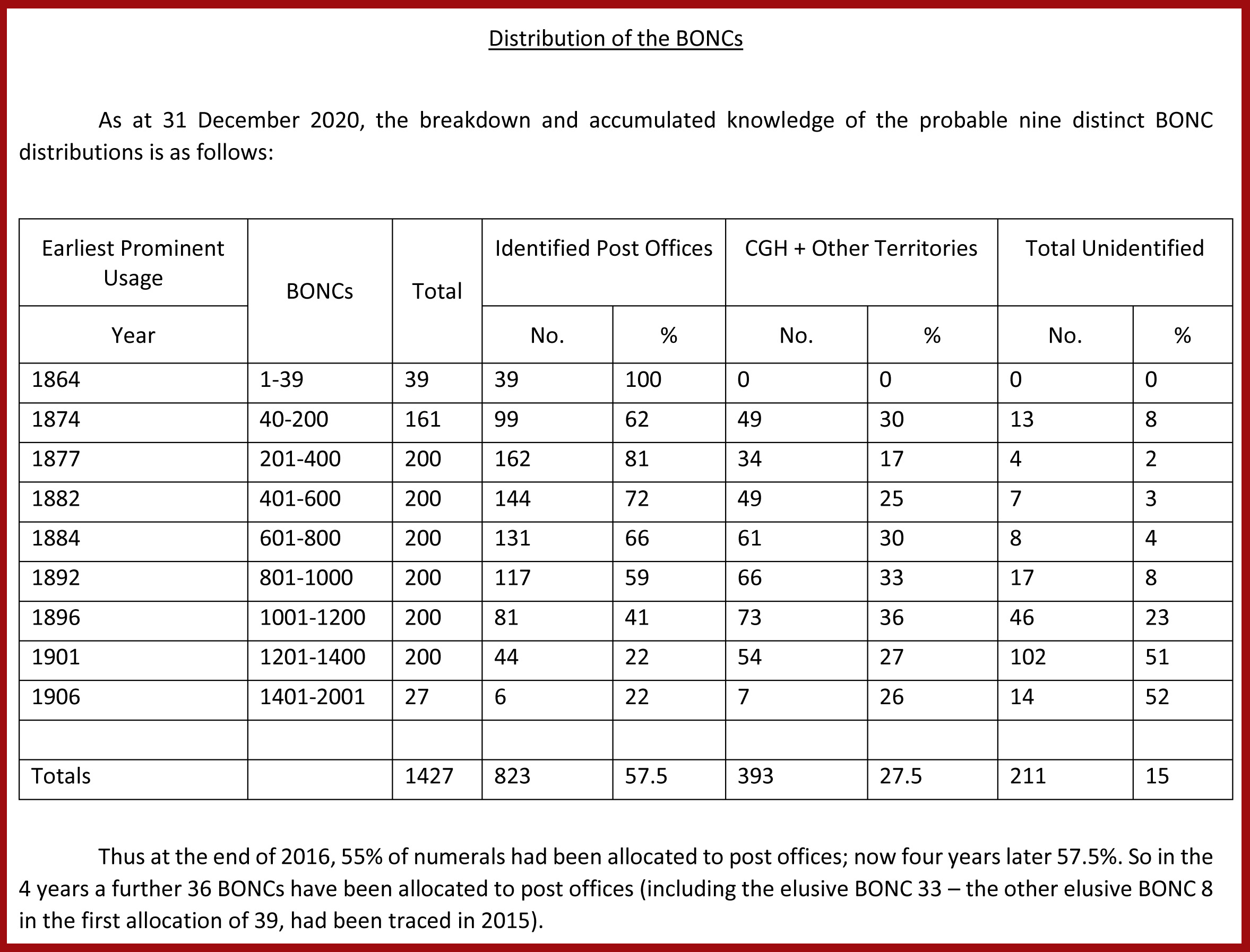
Below are two proving covers showing relatively late use of what appears to be the 1864 Thick Nine Bar BONC. One is from the Malmesbury post office and the other is from the town's railways station.
Thanks to Mordant's advice rubricated in red above I now know that there were multiple issues of a (3.3.3) BONC and that what appears to be a 1864/65 Thick Nine Bar BONC may be a much later release. We work out that the Malmesbury BONC 215 cannot be the first issue BONC because Frescura / Visser give the ER (Earliest Recorded) for it as '21 JY 1881' with an LR (Last Recorded) of '2 NO 1897' ie. it is not recorded used until 1881, so it is most unlikely to have been issued in 1864/65. Also, it appears to be a new LR of '20 AU 98'.
Malmesbury Station's BONC 235 (3.3.3) has a similar ER / LR of ' 31 MY 1881 to 24 MY 1894'. Given that their recorded use started so late, I questioned how it was that these two devices were held back for so long before being issued. Thanks to David Mordant I now know that there were multiple issues of the Cape BONC and that these ones were probably from the collective issue of 1877. So, just as I am thinking I can sleep easier tonight I am worrying about why they do not have earlier ERs. I would hope it was a rolling issue.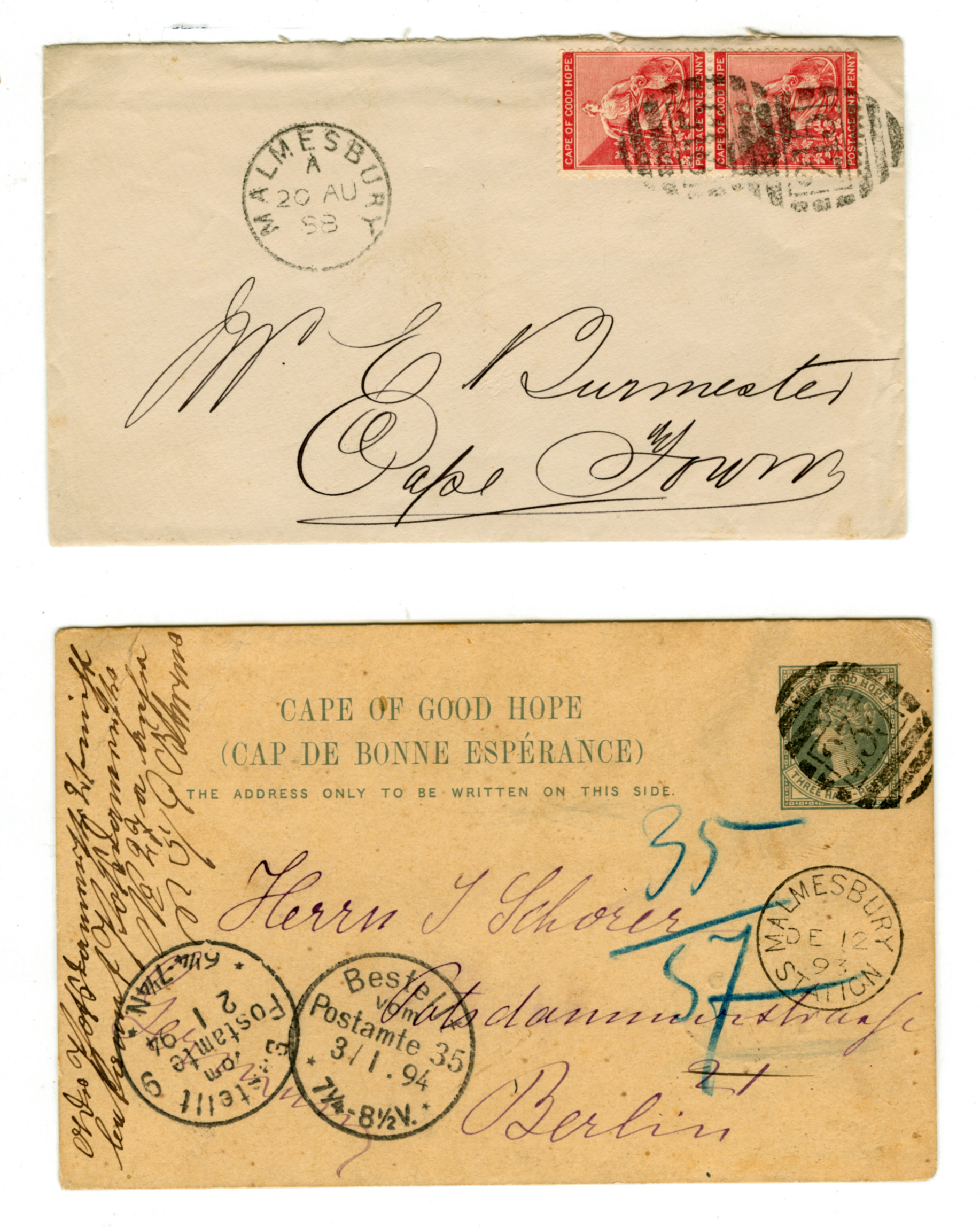
Quote from Steve on December 11, 2023, 10:17 amDifferent Types and Shapes of BONCs
The differences between BONCs is surprising. These varieties are well-illustrated in Goldblatt's book. However, while Franco Frescura's and Alex Visser's 'Post Offices and Postal Markings of the Cape of Good Hope' (2021) is a better source of up-to-date knowledge about their ERs and LRs, their book's absence of detailed illustrations and examples is a major disappointment and weakness.
The BONCs of Kimberley
As the first part in the study of the different types on BONCs we will examine the five used in Kimberely. In 1864 when the BONC was issued at the Cape, diamonds had yet to be discovered. After their discovery in 1866/67, Kimberley's diamond wealth made it the Cape's second most important town by the 1890s. Some believed it was even more important than Cape Town, the seat of government.
Kimberley received a Thick Nine Bar BONC 227 (as well as other very interesting types of BONC. See next.). As there is no record (yet) of BONC 227 being used elsewhere, this Thick Nine Bar BONC must have been held back and issued to Kimberley when the diamond diggings' postal needs grew to a point that demanded it. Well, perhaps not! Frescura / Visser tell us that two versions of the Thick Nine Bar BONC (3.3.3) have been recorded '22 AP 1891 to 11 AP 1903'. But their book holds no example of these two types - what are the differences?. The dates for these 'two types recorded' have been rolled into one. Oh dear! Their full Kimberley BONC listing states:
BONC 227 (3.3.3) two types recorded '22 AP 1891 to 11 AP 1903'
BONC 227 (4.5.4) thinner bars '22 OC 1881'
BONC 227 (5.6.5) thin bars '27 AU 1887 to 22 SP 1900'
BONC 227 (6.6.6) thin bars '20 JY 1882 to 29 JY 1892'
BONC 227 (2.5.2) horizontal format '27 FE 1899'By way of explantion for those who are new to BONCs, the oval shape of the Thick Nine Bar BONC of 1864 is divided into three parts, a top and bottom of three horizontal bars of different length and a central section containg a numeral within a rectangle that has three short bars on either side. This is described as '3.3.3' A '5.6.5' has five horizontal bars of different length top and bottom and a central section containg a numeral within a rectangle that has six short bars on either side. The '2.5.2' is a different beast best illustrated.
The first thing we notice here is that the earliest recorded use of these BONCs is '22 OC 1881'. The second thing is that the BONC 227 (3.3.3) which has two types recorded '22 AP 1891 to 11 AP 1903' is so late as to have nothing to tie them to the BONC issue of 1864/65. All this talk about BONC 227 being held back now appears as pure speculation. I am now beginning to think that for Kimberley to receive a Thick Nine Bar BONCs (3.3.3) in 1891 it is possible that there was another order for BONCs that included this one.
Kimberley's Thick Nine Bar BONC of 1864 raises the interesting question of 'How do you date a BONC postmark?' In the absence of a proving cover's datestamp the closest you can get an to understanding this is by the issue date of the stamp it is on. As people bought postage stamps and kept them for years before using them, this is an extremely inexact method of dating their possible date of use.
Images
1]. A block of eight 5/- CoGH rectangles, possibly used to register a parcel of diamonds. I believe that there is an error with the reference to this BONC postmark's high price. I believe that refers to the next image, BONC Horizontal 227. Again, this appears to a Thick Nine Bar BONC of 1864 vintage. But can that be given this late use on 1896 issue stamps?
2]. The much sought after and more valuable BONC Horizontal 227 which I do not have. Image courtesy of R. Golodblatt.
I will continue this later - I now have to go our and buy a Christmas tree!
Different Types and Shapes of BONCs
The differences between BONCs is surprising. These varieties are well-illustrated in Goldblatt's book. However, while Franco Frescura's and Alex Visser's 'Post Offices and Postal Markings of the Cape of Good Hope' (2021) is a better source of up-to-date knowledge about their ERs and LRs, their book's absence of detailed illustrations and examples is a major disappointment and weakness.
The BONCs of Kimberley
As the first part in the study of the different types on BONCs we will examine the five used in Kimberely. In 1864 when the BONC was issued at the Cape, diamonds had yet to be discovered. After their discovery in 1866/67, Kimberley's diamond wealth made it the Cape's second most important town by the 1890s. Some believed it was even more important than Cape Town, the seat of government.
Kimberley received a Thick Nine Bar BONC 227 (as well as other very interesting types of BONC. See next.). As there is no record (yet) of BONC 227 being used elsewhere, this Thick Nine Bar BONC must have been held back and issued to Kimberley when the diamond diggings' postal needs grew to a point that demanded it. Well, perhaps not! Frescura / Visser tell us that two versions of the Thick Nine Bar BONC (3.3.3) have been recorded '22 AP 1891 to 11 AP 1903'. But their book holds no example of these two types - what are the differences?. The dates for these 'two types recorded' have been rolled into one. Oh dear! Their full Kimberley BONC listing states:
BONC 227 (3.3.3) two types recorded '22 AP 1891 to 11 AP 1903'
BONC 227 (4.5.4) thinner bars '22 OC 1881'
BONC 227 (5.6.5) thin bars '27 AU 1887 to 22 SP 1900'
BONC 227 (6.6.6) thin bars '20 JY 1882 to 29 JY 1892'
BONC 227 (2.5.2) horizontal format '27 FE 1899'
By way of explantion for those who are new to BONCs, the oval shape of the Thick Nine Bar BONC of 1864 is divided into three parts, a top and bottom of three horizontal bars of different length and a central section containg a numeral within a rectangle that has three short bars on either side. This is described as '3.3.3' A '5.6.5' has five horizontal bars of different length top and bottom and a central section containg a numeral within a rectangle that has six short bars on either side. The '2.5.2' is a different beast best illustrated.
The first thing we notice here is that the earliest recorded use of these BONCs is '22 OC 1881'. The second thing is that the BONC 227 (3.3.3) which has two types recorded '22 AP 1891 to 11 AP 1903' is so late as to have nothing to tie them to the BONC issue of 1864/65. All this talk about BONC 227 being held back now appears as pure speculation. I am now beginning to think that for Kimberley to receive a Thick Nine Bar BONCs (3.3.3) in 1891 it is possible that there was another order for BONCs that included this one.
Kimberley's Thick Nine Bar BONC of 1864 raises the interesting question of 'How do you date a BONC postmark?' In the absence of a proving cover's datestamp the closest you can get an to understanding this is by the issue date of the stamp it is on. As people bought postage stamps and kept them for years before using them, this is an extremely inexact method of dating their possible date of use.
Images
1]. A block of eight 5/- CoGH rectangles, possibly used to register a parcel of diamonds. I believe that there is an error with the reference to this BONC postmark's high price. I believe that refers to the next image, BONC Horizontal 227. Again, this appears to a Thick Nine Bar BONC of 1864 vintage. But can that be given this late use on 1896 issue stamps?
2]. The much sought after and more valuable BONC Horizontal 227 which I do not have. Image courtesy of R. Golodblatt.
I will continue this later - I now have to go our and buy a Christmas tree!
Uploaded files:Quote from yannisl on December 14, 2023, 1:08 amInteresting write-up, thanks for posting it. Since I wrote the question some months back, here are some further thoughts. My question was focusing primarily on BONCs on stamps. I think here we all agree that maybe they do not belong on an exhibit, but maybe on a write-up. Writing up a collection has a lot of merits for the collector. For covers I like your presentation, anchoring it on the triangulars and the BONCs are then the side story, but getting any triangular with a BONC on a cover, is almost impossible and very expensive. In my case since I did a bit of write up and connected the BONCs with the circulars on one write-up and on a second I connected them with the experimentals. As an aside one of the most interesting aspect of the BONCs are the duplexes, I think here the literature is both incomplete and wrong in some places. Hope your Simon's Town presentation went well and I was expecting to see you posting extracts of it here.
Interesting write-up, thanks for posting it. Since I wrote the question some months back, here are some further thoughts. My question was focusing primarily on BONCs on stamps. I think here we all agree that maybe they do not belong on an exhibit, but maybe on a write-up. Writing up a collection has a lot of merits for the collector. For covers I like your presentation, anchoring it on the triangulars and the BONCs are then the side story, but getting any triangular with a BONC on a cover, is almost impossible and very expensive. In my case since I did a bit of write up and connected the BONCs with the circulars on one write-up and on a second I connected them with the experimentals. As an aside one of the most interesting aspect of the BONCs are the duplexes, I think here the literature is both incomplete and wrong in some places. Hope your Simon's Town presentation went well and I was expecting to see you posting extracts of it here.
Quote from Steve on December 14, 2023, 1:42 pmWhat a welcome reply. Thank you Yannisl. Essentially, I am just trying to provide a BONC converstaion that offers encouragement and direction to anyone displaying or writing-up their BONCs. I disagree (as always!) that they 'do not belong on an exhibit' - they are a wonderful and relatively misunderstood collecting field that wrecked millions of Cape stamps. As the BONC was fundamentally an obliterator for the first Rectangular issue, I thought to start with their short-lived cancelling of its predecessor, the classic Cape Triangular adhesive. I agree 'getting any triangular with a BONC on a cover, is almost impossible and very expensive', which is why ALL my examples are on piece.
I think I may be faulted for being so hard on Goldblatt in this posting. In my defence, his work formed many of my earliest opinions about Cape postmarks, especially the BONC and the various datestamps used with it. I am angry with myself for taking his advice at face value. I now have to rewrite many Cape display pages as new research debunks my opinions. I am not done with this post yet and plan to cover BONC varities with some examples on cover, duplexes (please post some of your examples) and non-Cape use assuming I can find them. The literature 'IS VERY DEFINITELY INCOMPLETE AND WRONG IN SOME PLACES'. Thanks for confirming this. Frescura and Mordant have done a lot to update our knowledge. Hopefully others reading this will be more circumspect before leaping to the same wrong conclusions I made.
As there was no slot available for me at the SAC's conference it was agreed I could put up a 'silent' Simonstown display in the hour after breakfast before the morning's programme began. Some joked it was the only way they could get me to shut up! Nevertheless, my display was well received. Luminaries like Ian Shapiro, David Morrison and Tony H-G provided advice that made me reappraise some of it. Ian pointed out the rarirty of a Registered Soldier and Seaman's rate cover that I took for granted. It must have contained money, he said. David advised that Cape Town 'briefstok' mail is not recorded travelling as far as Simonstown. Tony noted an accounting mark I had overlooked. What was most pleasing was that Jamie Smith, my partner in this SAPC adventure, a postal historian whose work I admire and respect, someone whom I had never met prior to the SACs Meriden meeting, liked it. Now that's worth a GOLD medal any day of the week!
What a welcome reply. Thank you Yannisl. Essentially, I am just trying to provide a BONC converstaion that offers encouragement and direction to anyone displaying or writing-up their BONCs. I disagree (as always!) that they 'do not belong on an exhibit' - they are a wonderful and relatively misunderstood collecting field that wrecked millions of Cape stamps. As the BONC was fundamentally an obliterator for the first Rectangular issue, I thought to start with their short-lived cancelling of its predecessor, the classic Cape Triangular adhesive. I agree 'getting any triangular with a BONC on a cover, is almost impossible and very expensive', which is why ALL my examples are on piece.
I think I may be faulted for being so hard on Goldblatt in this posting. In my defence, his work formed many of my earliest opinions about Cape postmarks, especially the BONC and the various datestamps used with it. I am angry with myself for taking his advice at face value. I now have to rewrite many Cape display pages as new research debunks my opinions. I am not done with this post yet and plan to cover BONC varities with some examples on cover, duplexes (please post some of your examples) and non-Cape use assuming I can find them. The literature 'IS VERY DEFINITELY INCOMPLETE AND WRONG IN SOME PLACES'. Thanks for confirming this. Frescura and Mordant have done a lot to update our knowledge. Hopefully others reading this will be more circumspect before leaping to the same wrong conclusions I made.
As there was no slot available for me at the SAC's conference it was agreed I could put up a 'silent' Simonstown display in the hour after breakfast before the morning's programme began. Some joked it was the only way they could get me to shut up! Nevertheless, my display was well received. Luminaries like Ian Shapiro, David Morrison and Tony H-G provided advice that made me reappraise some of it. Ian pointed out the rarirty of a Registered Soldier and Seaman's rate cover that I took for granted. It must have contained money, he said. David advised that Cape Town 'briefstok' mail is not recorded travelling as far as Simonstown. Tony noted an accounting mark I had overlooked. What was most pleasing was that Jamie Smith, my partner in this SAPC adventure, a postal historian whose work I admire and respect, someone whom I had never met prior to the SACs Meriden meeting, liked it. Now that's worth a GOLD medal any day of the week!
Quote from Steve on February 18, 2024, 10:08 amNew Discovery: Latest Recorded Date of Use for BONC 300 - Walfish Bay
The following has been discovered by Mike Berry. He writes: "Looking through my Walfish Bay covers today, I noted my BONC 300 cancel is dated AP 11 99. Franco's online listing shows Last Recorded 4 MR 99 at the time of 2021 review".
Thanks, Mike. What a smashing postcard! It breaks new ground, destroys old assumptions, etc., etc., etc. I think it safe to say that this is a new Last Recorded date and that the records should accordingly be revised and reconstructed upwards.
New Discovery: Latest Recorded Date of Use for BONC 300 - Walfish Bay
The following has been discovered by Mike Berry. He writes: "Looking through my Walfish Bay covers today, I noted my BONC 300 cancel is dated AP 11 99. Franco's online listing shows Last Recorded 4 MR 99 at the time of 2021 review".
Thanks, Mike. What a smashing postcard! It breaks new ground, destroys old assumptions, etc., etc., etc. I think it safe to say that this is a new Last Recorded date and that the records should accordingly be revised and reconstructed upwards.
